Tag: Primer
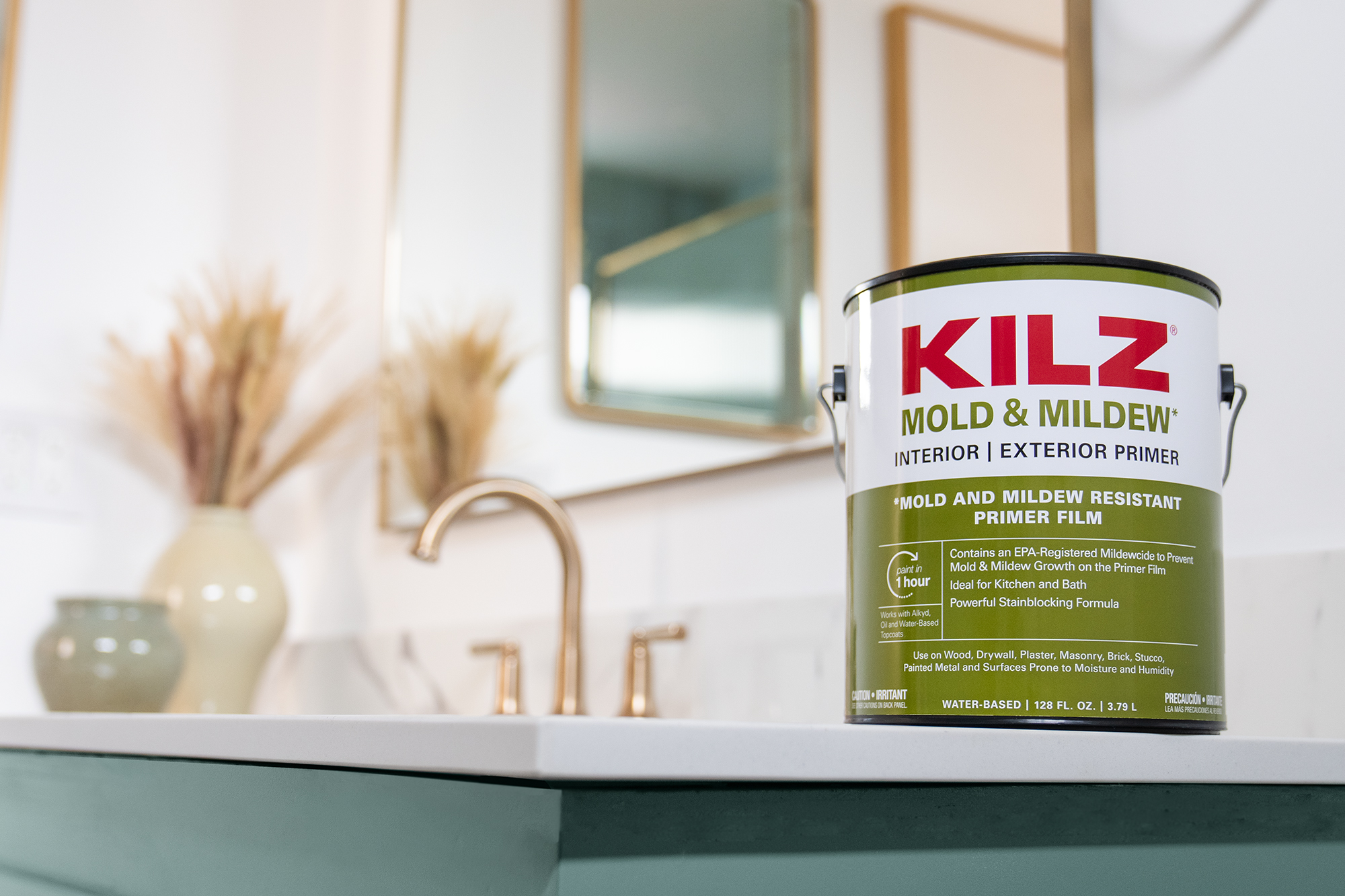
Can You Paint Over Mold With KILZ® Mold & Mildew Primer?
January 16, 2025Does KILZ Mold & Mildew Primer prevent mold and mildew?
KILZ Mold & Mildew Primer prevents mold and mildew growth on the primer film/primer surface. It is important to ensure that the surface is mold and mildew free before the primer and topcoat paint is applied. It is however, not supposed to be applied directly to mold (especially the black or yellowish, wet, slimy type). In those situations, proper health protective measures should be immediately taken and the mold removed properly with quality mold removing products or with a professional before attempting to apply primer and paint over the surface. To learn how to remove mold from your home, please visit: EPA: A Brief Guide to Mold, Moisture and Your Home | US EPA.
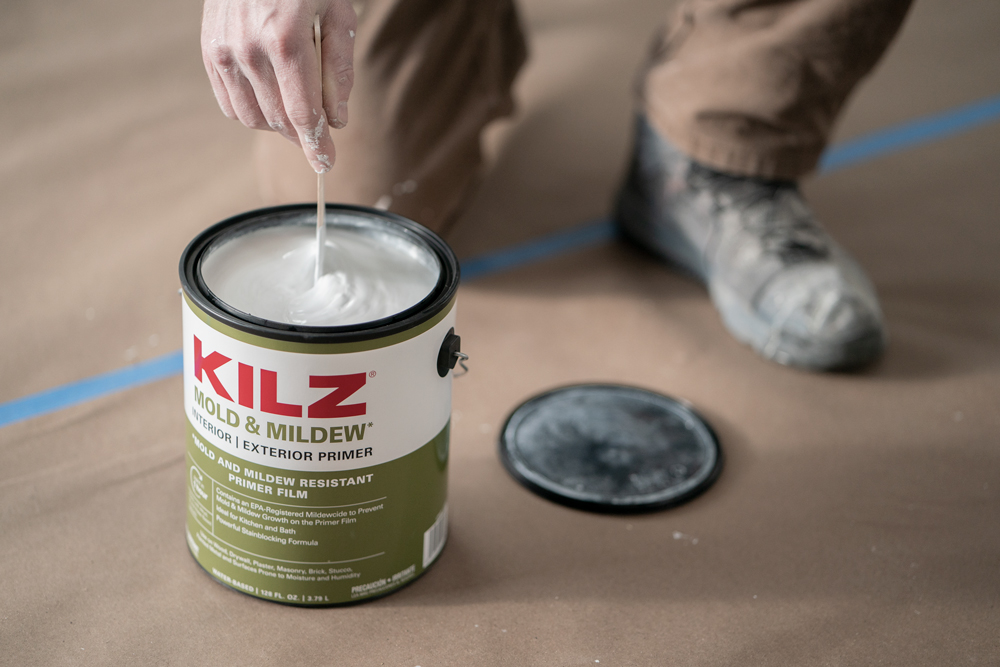
What are the dangers of painting over mold and mildew?
Painting directly over mold and mildew goes against best paint practices and is not recommended. Mold is a living organism that thrives in a moisture environment so painting (or priming) over it, does not kill it. If the moldy surface is not properly cleaned before priming with KILZ® Mold & Mildew, it will likely continue to grow underneath the paint and eventually come back out through paint that cracks or peels or through the back of the wall or surface, especially if it remains damp or wet.
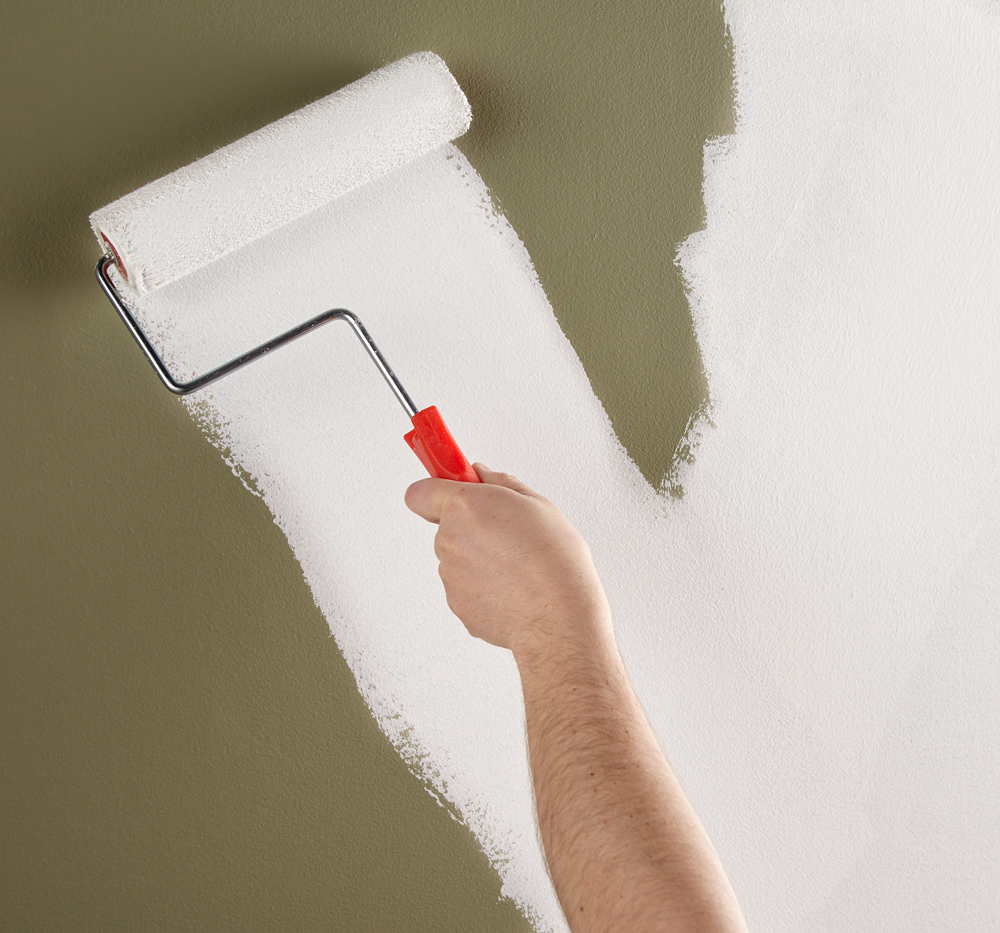
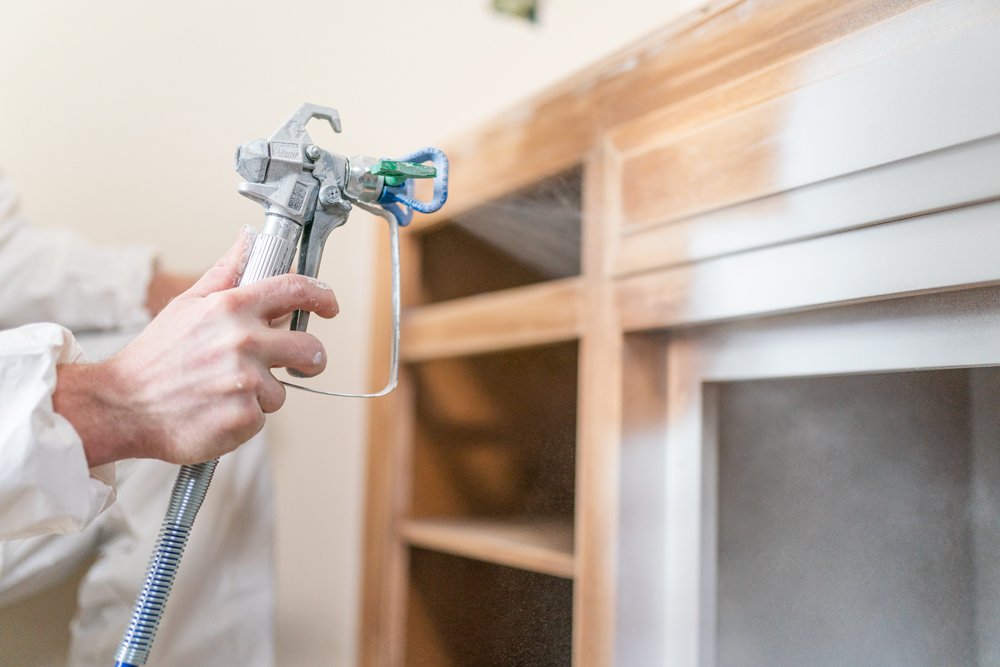
How to use KILZ Mold and Mildew Primer?
KILZ Mold & Mildew Primer is ideal for interior and exterior spaces prone to high moisture and humidity. Think bathrooms, kitchens, laundry rooms, powder rooms, patio kitchens, pool decks, greenhouses, etc. It contains an EPA certified mildewcide which prevents mold and mildew growth on the primer film. It will help ensure the primer coat and primed surface is mildew or mold free prior to applying the topcoat so there are no active organisms trapped inside. Aside from this, KILZ Mold & Mildew Primer also has a high hiding white finish which hides previous colors, stains, graffiti and other marks and blemishes. It is also a medium level stain blocker which prevents stains like pen, marker, lipstick, grease, nicotine, water and light tannin bleed from leaching through the paint finish.
Prior to applying the primer, remove any mold or mildew with a proper remover or have it removed by a professional. In severe cases, the moldy substrates may need to be replaced. Once the surface is mold and mildew free, ensure it is clean and dry before applying primer. KILZ Mold & Mildew Primer also has very low VOC making it safer to use and better for the environment and can be applied easily using a brush, roller or sprayer. It also comes in a handy 13 oz spray version for convenient spot priming, touch-ups or small spray projects.
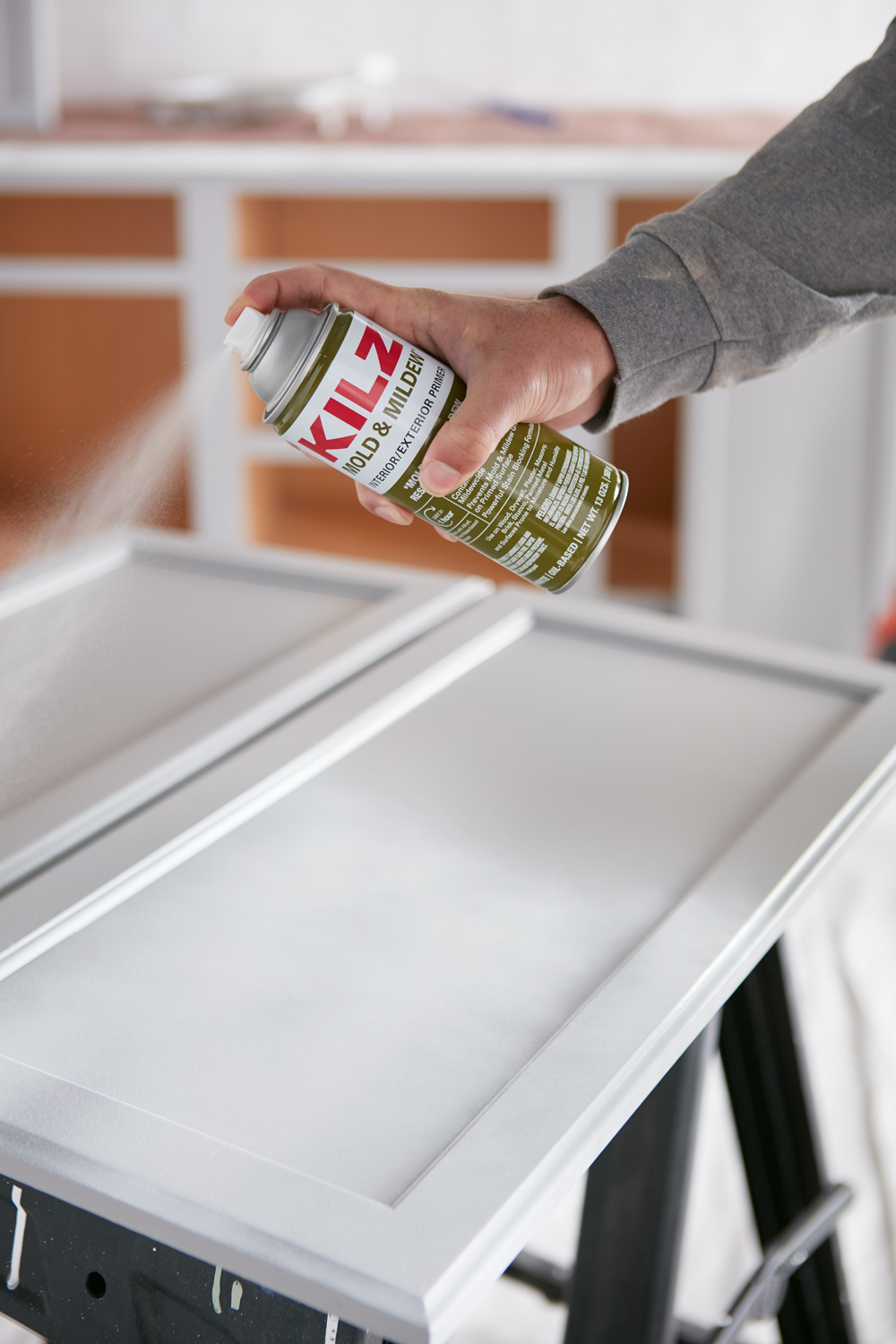
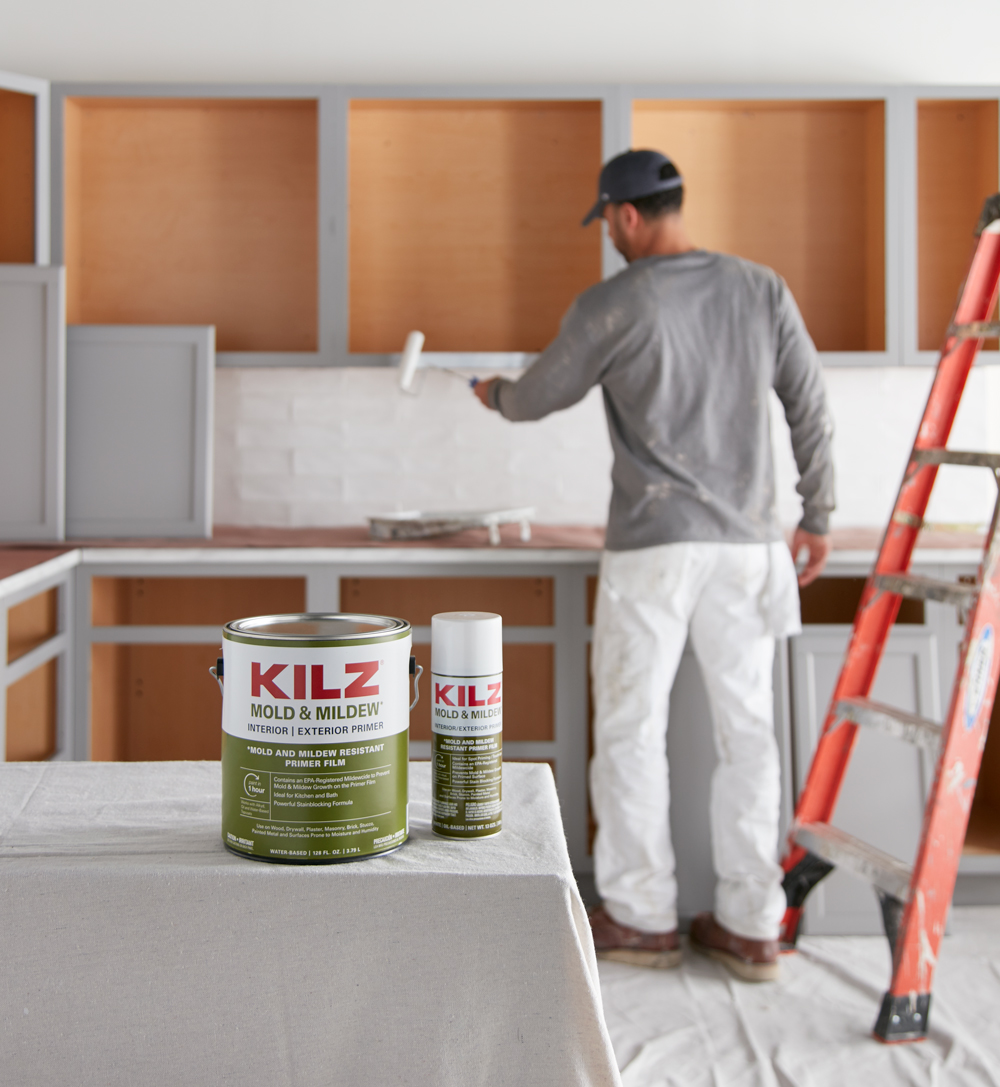
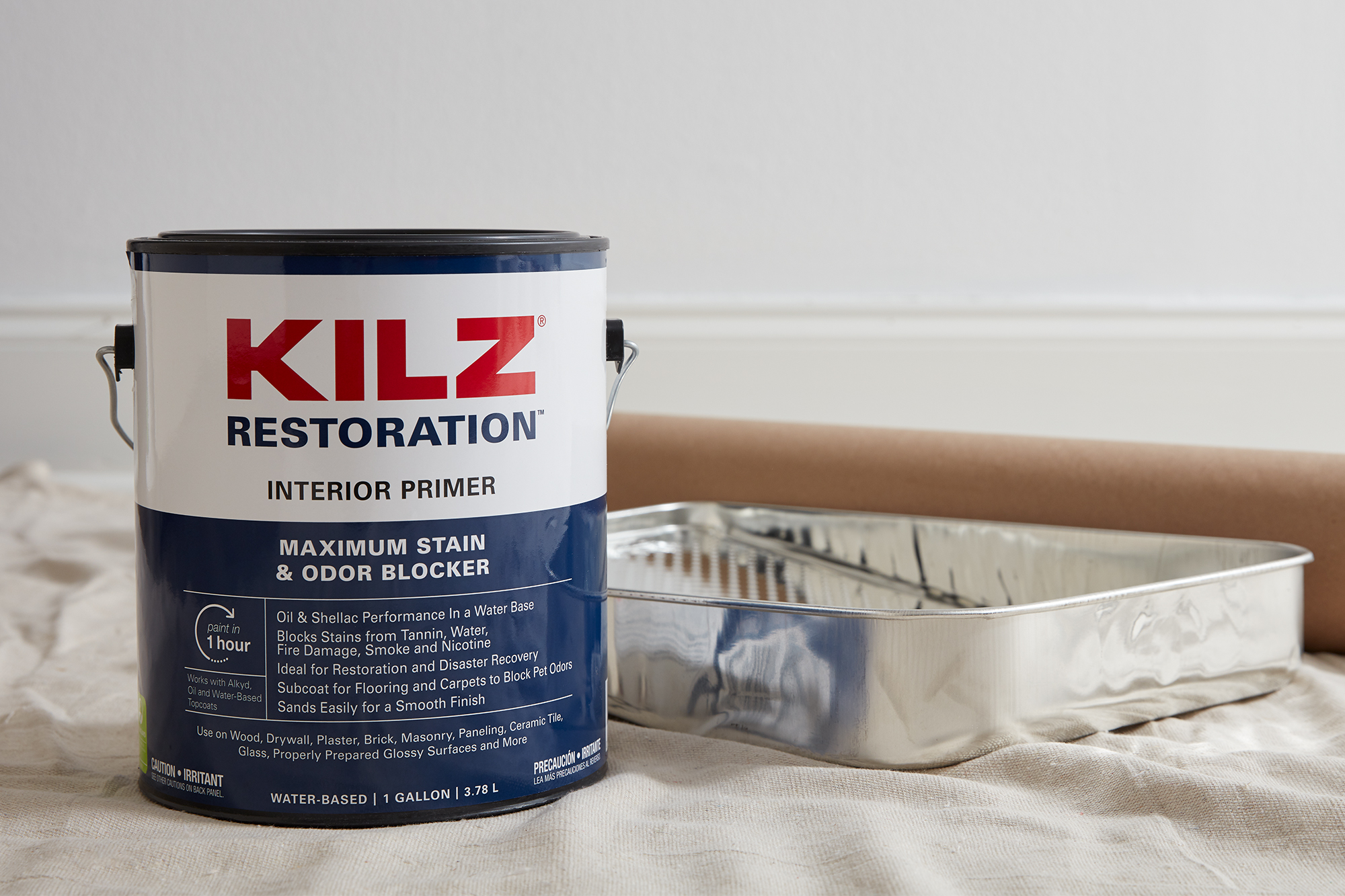
PRO SPOTLIGHT: MARK ROBERTSON COMPLETES CUSTOM BUILT-INS WITH KILZ®
August 28, 2024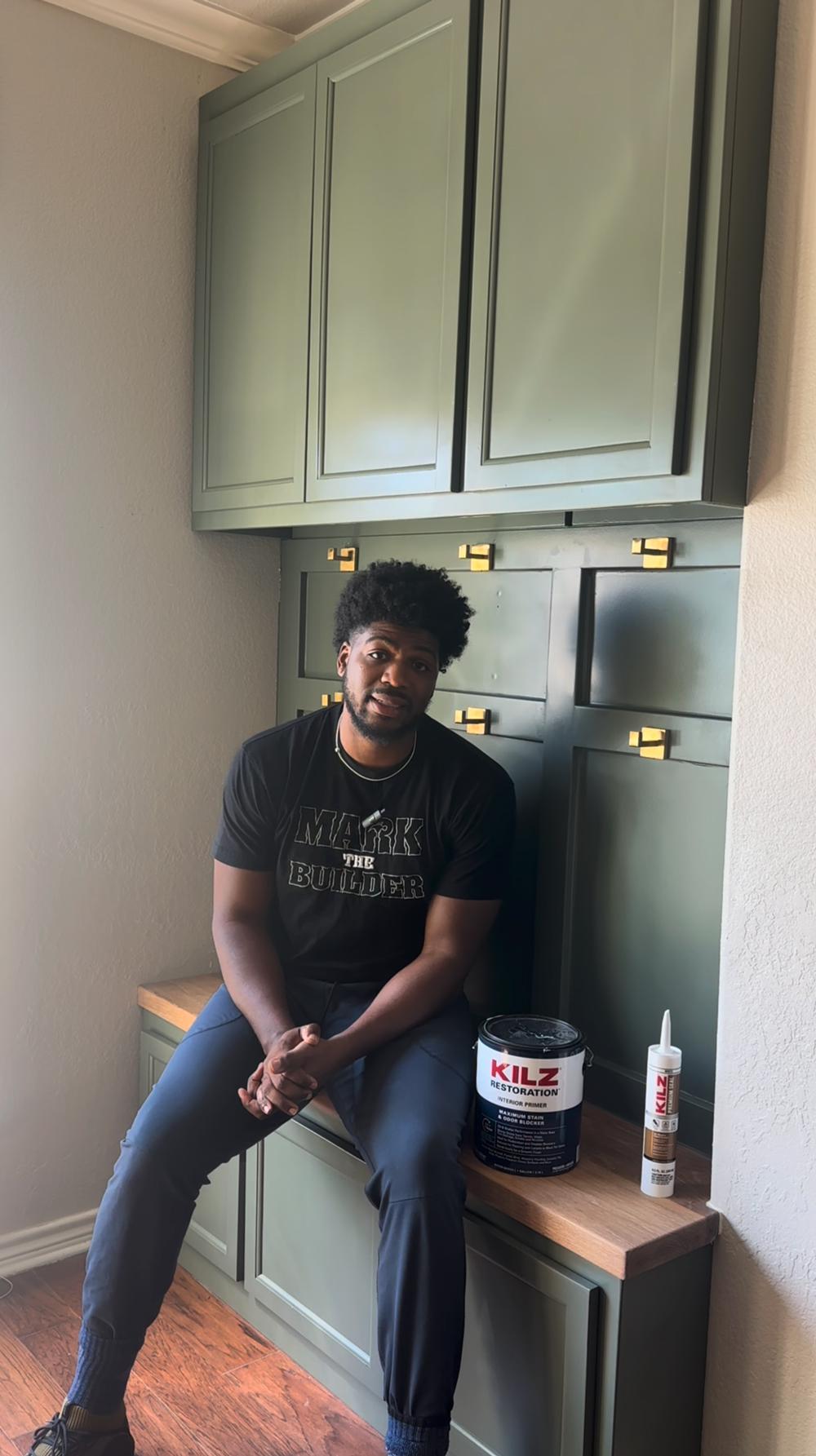 Hi, I’m Mark The Builder! I am a woodworker, husband, father, and so much more. I enjoy creating projects and delivering beautiful carpentry to my clients and also for my own home. As a woodworking enthusiast, I take great satisfaction in crafting built-in structures. After purchasing our home, my wife and I planned a remodel to better fit our needs. We recently started renovating our formal dining room into an office, including a T-shaped desk that will serve as two L-shaped working areas for my wife and me. After finishing the first phase of the office built-in, we realized we had enough material to also complete a built-in for the mudroom area within the office. This addition provides extra storage and a designated area for our children to hang their backpacks, with drawers to put additional school supplies, shoes, toys, and more. There is also a wall plug that can serve as a charging station for our oldest son’s school Chromebook. As with previous built-ins projects, I used KILZ RESTORATION® Primer as a base before painting and KILZ® PREMIUM SEAL to ensure a flawless finish along the seams.
Hi, I’m Mark The Builder! I am a woodworker, husband, father, and so much more. I enjoy creating projects and delivering beautiful carpentry to my clients and also for my own home. As a woodworking enthusiast, I take great satisfaction in crafting built-in structures. After purchasing our home, my wife and I planned a remodel to better fit our needs. We recently started renovating our formal dining room into an office, including a T-shaped desk that will serve as two L-shaped working areas for my wife and me. After finishing the first phase of the office built-in, we realized we had enough material to also complete a built-in for the mudroom area within the office. This addition provides extra storage and a designated area for our children to hang their backpacks, with drawers to put additional school supplies, shoes, toys, and more. There is also a wall plug that can serve as a charging station for our oldest son’s school Chromebook. As with previous built-ins projects, I used KILZ RESTORATION® Primer as a base before painting and KILZ® PREMIUM SEAL to ensure a flawless finish along the seams.
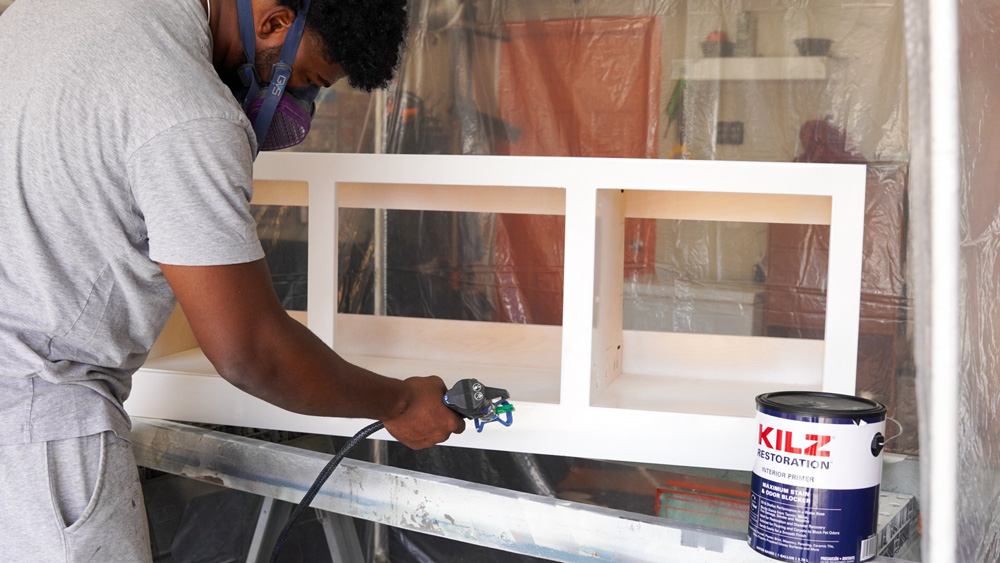
My wife and I chose BEHR® Sage Green ICC-77 with gold finishings to match our office built-in. And to top it off, no pun intended, we picked a white oak wood with a smoke stain finish, which perfectly matches the Sage Green paint and the desk tops. Our vision for the office is a sleek, modern feel. We plan to remove the arch in the walkway to install glass doors at the entrance of the office and close up the opening that leads to our kitchen.
In the garage, I set up my indoor painting area with stands and a drop cloth underneath. This is where I sanded and used KILZ RESTORATION® Primer on the upper and lower cabinetry, as well as on the doors. I applied two coats of primer using a paint sprayer for a smooth and even finish. After completing the cabinetry, I sanded and primed the slats for the mudroom built-in accent wall. I like to prime, sand, prime again, and sand the slats for a smooth foundation. Once the primer dried, with the help of the wind and my fans, I applied one coat of BEHR Sage Green, achieving a smooth, beautiful, and flawless finish. Then, it was time to put it all together in the office!
I installed the base by cutting the trim around the baseboard to fit it perfectly, making it look as though it was built into the house. I secured it with a wooden anchor behind the base, attaching it to the wall. After securing it, I added the oak wood top to create a bench for the kids to sit while putting on their shoes. Next, I assembled the accent wall and smoothed out the seams using the KILZ® PREMIUM SEAL before adding a coat of paint. Then, it was time to install the upper cabinetry before installing gold hooks.
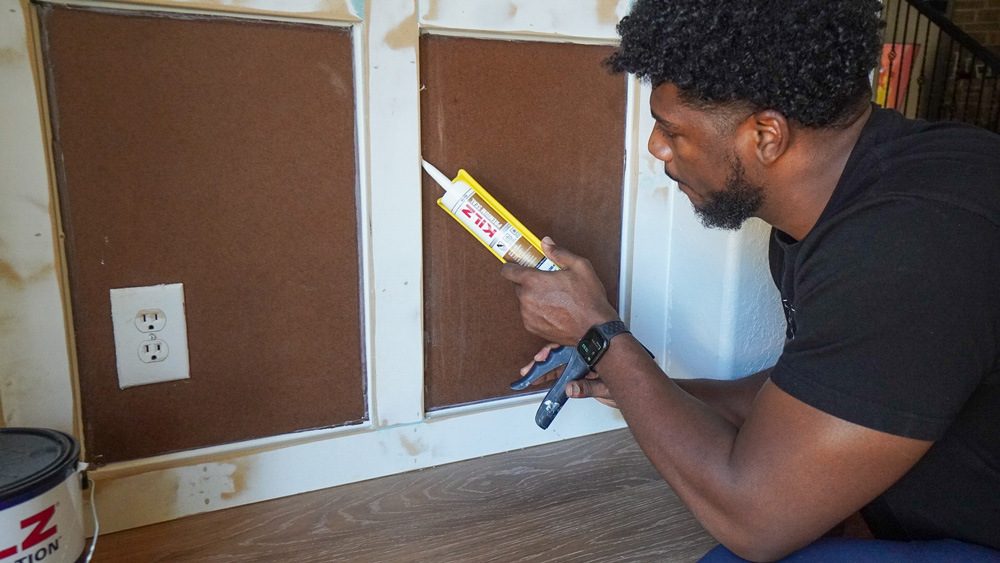
I really enjoyed using KILZ RESTORATION® Primer as it is a versatile water-based primer, sealer, and stain blocker. It effectively tackles tough stains like heavy water damage, smoke, grease, crayons, pencil, and pet stains while sealing persistent odors. It can be used on interior surfaces including woodwork, plaster, brick, ceramic tile, and glass. The KILZ® PREMIUM SEAL was the perfect finishing touch to add to the pre-painting process as it offers great durability and stretch, even capable of sealing active leaks.
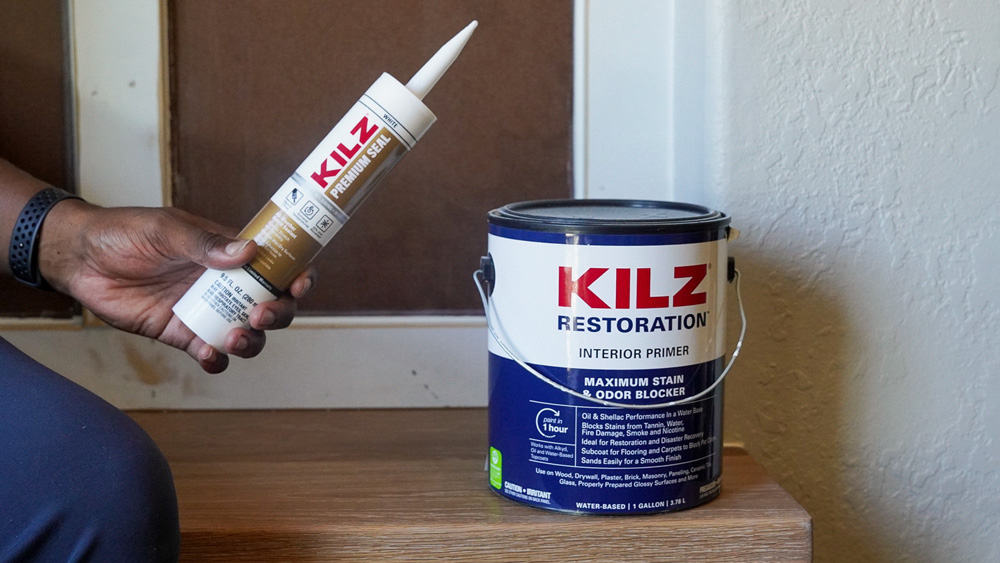
Overall, I’m happy we added this new addition to the office, which also provides an organized space for our kids to place their things. It blends perfectly with the rest of the space, and I couldn’t have done it without KILZ. I can’t wait until the rest of the office is complete!
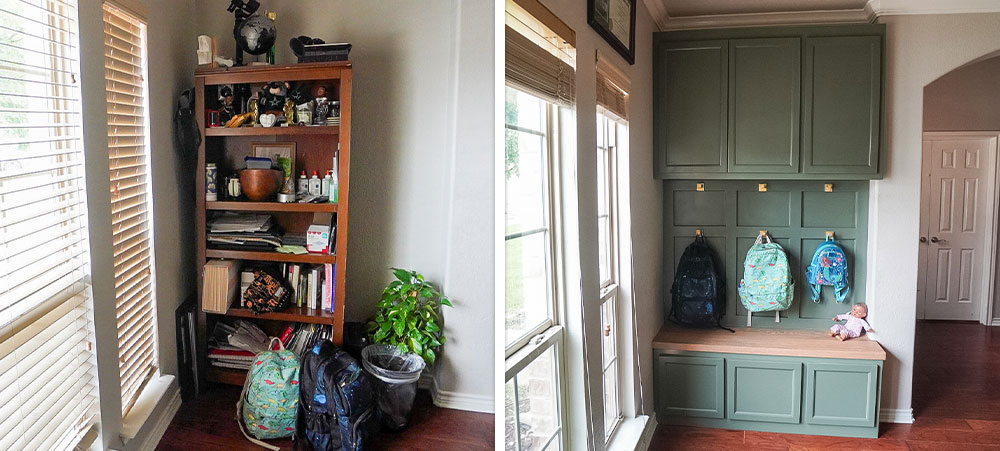
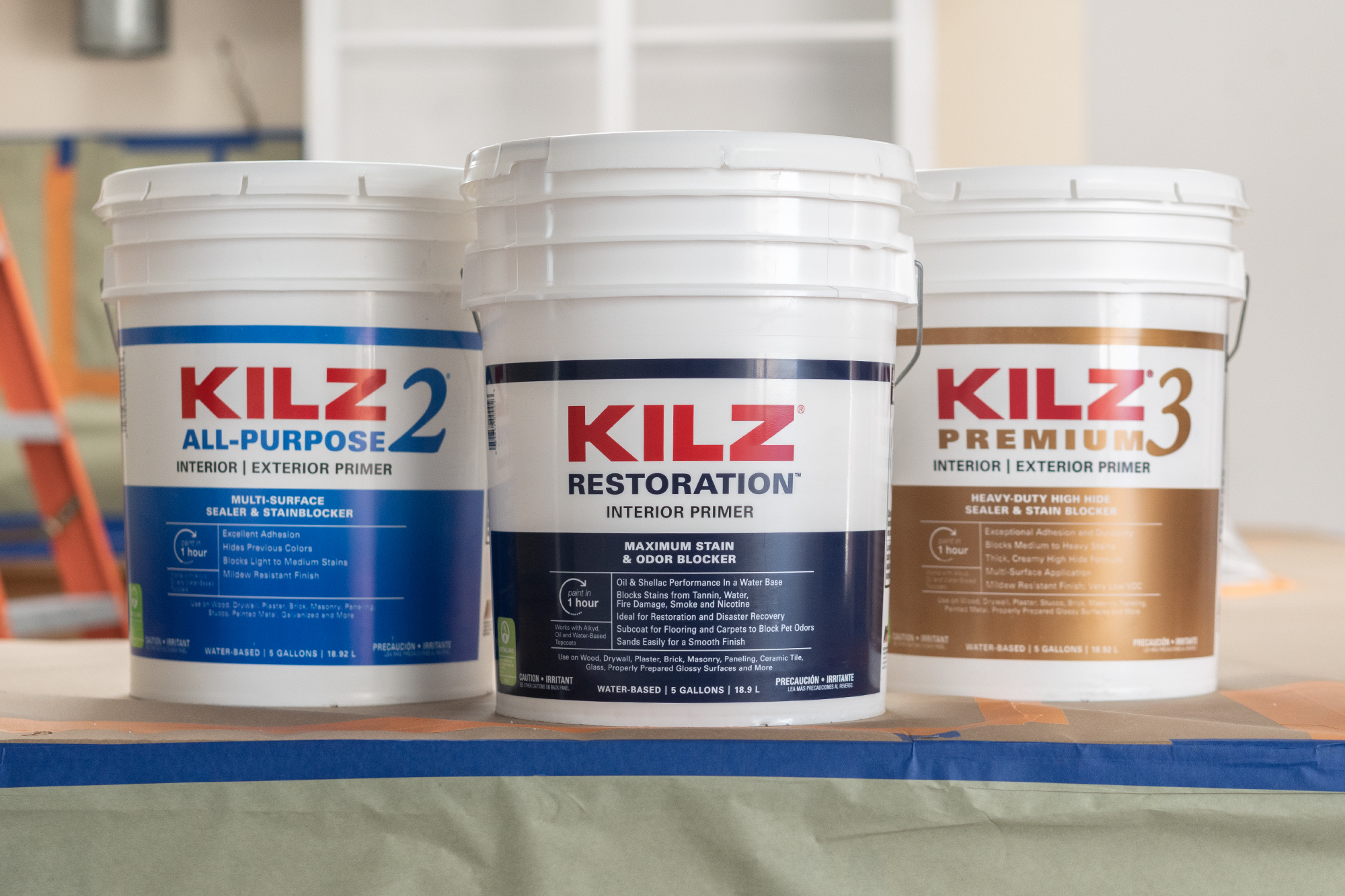
DIY Made Easy with KILZ® Primer
April 2, 2024Getting started
DIY’ers know that when it comes to home restoration and remodeling, shortcuts can’t be taken. Perfect painting requires the perfect primer to solve the multitude of problems that any surface presents. Ensuring you have the right foundation with a quality primer like KILZ® can set you up for success. This guide simplifies the selection process for primers that best fits your project and outlines the essential tools for application.
Why Prime?
Primer ensures your paint adheres to the surface properly, making it last longer. It achieves even color and full coverage with fewer coats, prevents old stains and colors from bleeding through, and adds a protective layer, which is vital for exterior projects.
The first step in any project is making a Painting Checklist of all the tasks you’ll need to take on. Know your surfaces and space. Whether you’re priming to paint outdoors or indoors, on wood, glass, metal or drywall, each scenario requires a specialized primer and process.
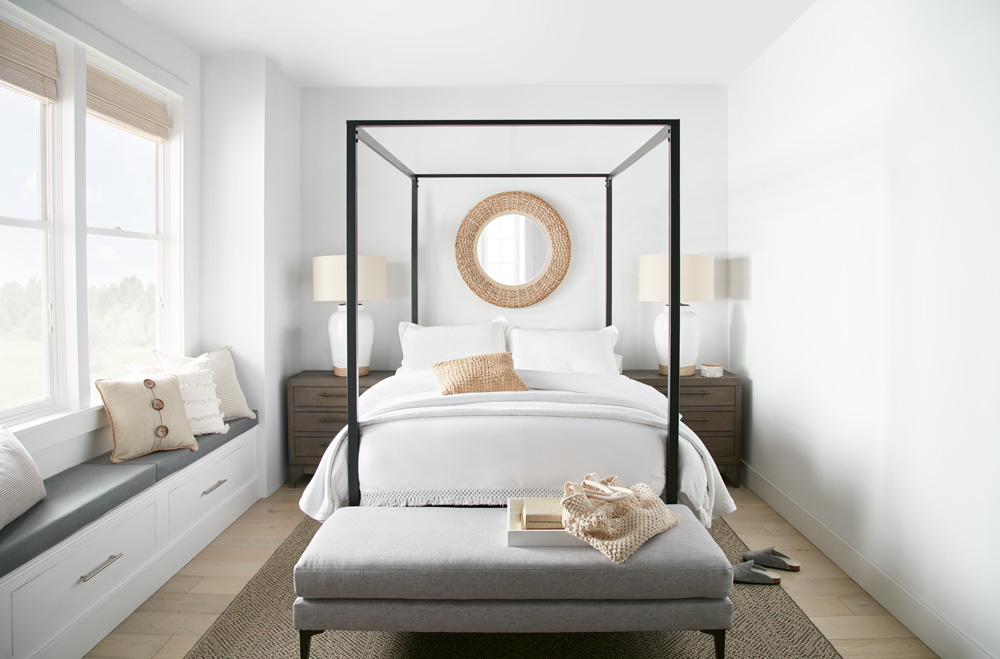
Choosing the Right KILZ® Primer
KILZ 2® All Purpose
• Ideal For: Indoor/outdoor use.
• Highlights: Fast drying, water-based, multi-surface primer-sealer-stain blocker with excellent adhesion and mildew resistance.
KILZ 3® Premium
• Ideal For: Versatile indoor/outdoor use on wood, plaster, concrete, etc.
• Highlights: High-hiding formula is great for color change and blocking medium to heavy stains.
KILZ Restoration®
• Ideal For: Addressing heavy-duty stains like smoke or water damage.
• Highlights: Combines oil-based primer benefits with water-based formula ease.
KILZ® Adhesion
• Ideal For: Difficult surfaces like glossy finishes, PVC, or metal.
• Highlights: Enhances paint adhesion where traditional primers fail.
KILZ® Mold & Mildew
• Ideal For: Moisture-prone and high-humidity environments such as kitchens, bathrooms, and laundry rooms.
• Highlights: A stain-blocking primer that resists mold and mildew growth on the primer film.
Required Tools And Preparation
Preparing your surface is an important step before applying primer, never prime over a dirty surface, clean your surface as best you can before you apply primer.
Here’s what you’ll need for primer application:
• Brushes: High-quality brushes are essential for cutting in around edges and in tight spaces. A 2-3 inch angled brush is versatile for most projects.
• Rollers: For larger surfaces, a roller can make the application quicker and more efficient. Use a roller with the appropriate nap length for your surface; smoother surfaces require a shorter nap.
• Paint Tray: Essential for holding primer and rolling out excess before application.
• Sandpaper: After the primer dries, you might need fine-grit sandpaper (around 220 grit) for smoothing out any bumps or imperfections.
• Drop Cloths: Protect your floors and furniture from drips and spills.
• Painter’s Tape: Use this to mask off areas you don’t want primed, such as trim or windows.

Applying Primer
Follow these 4 steps for proper primer application:
1. Surface Prep: Clean and sand your surface as needed to ensure it is smooth and ready for primer.
2. Apply Primer: With your chosen tools, apply the primer in even, controlled strokes or rolls, following the specific directions for your Kilz product.
3. Inspect and Sand: After drying, check for drips or rough spots, sanding lightly if necessary.
4. Paint Application: Once the primer is dry, proceed with painting, enjoying the smooth base your primer has created.
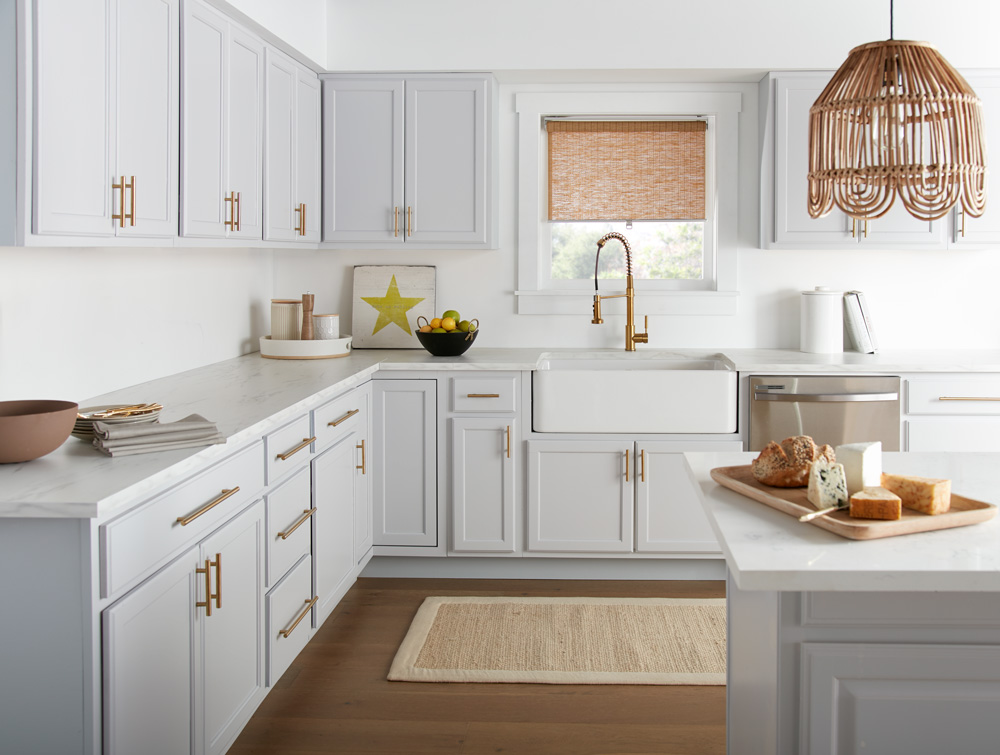
Your Surface Is Now Ready For Paint
Selecting the right KILZ® primer and using the proper tools for application can dramatically affect the quality and longevity of your project. Whether tackling a small piece of furniture or an entire room, starting with a solid foundation will ensure a professional-looking finish that lasts. Dive into your project with confidence, knowing you’re equipped with the best products and tools for the job.
Happy DIYing!
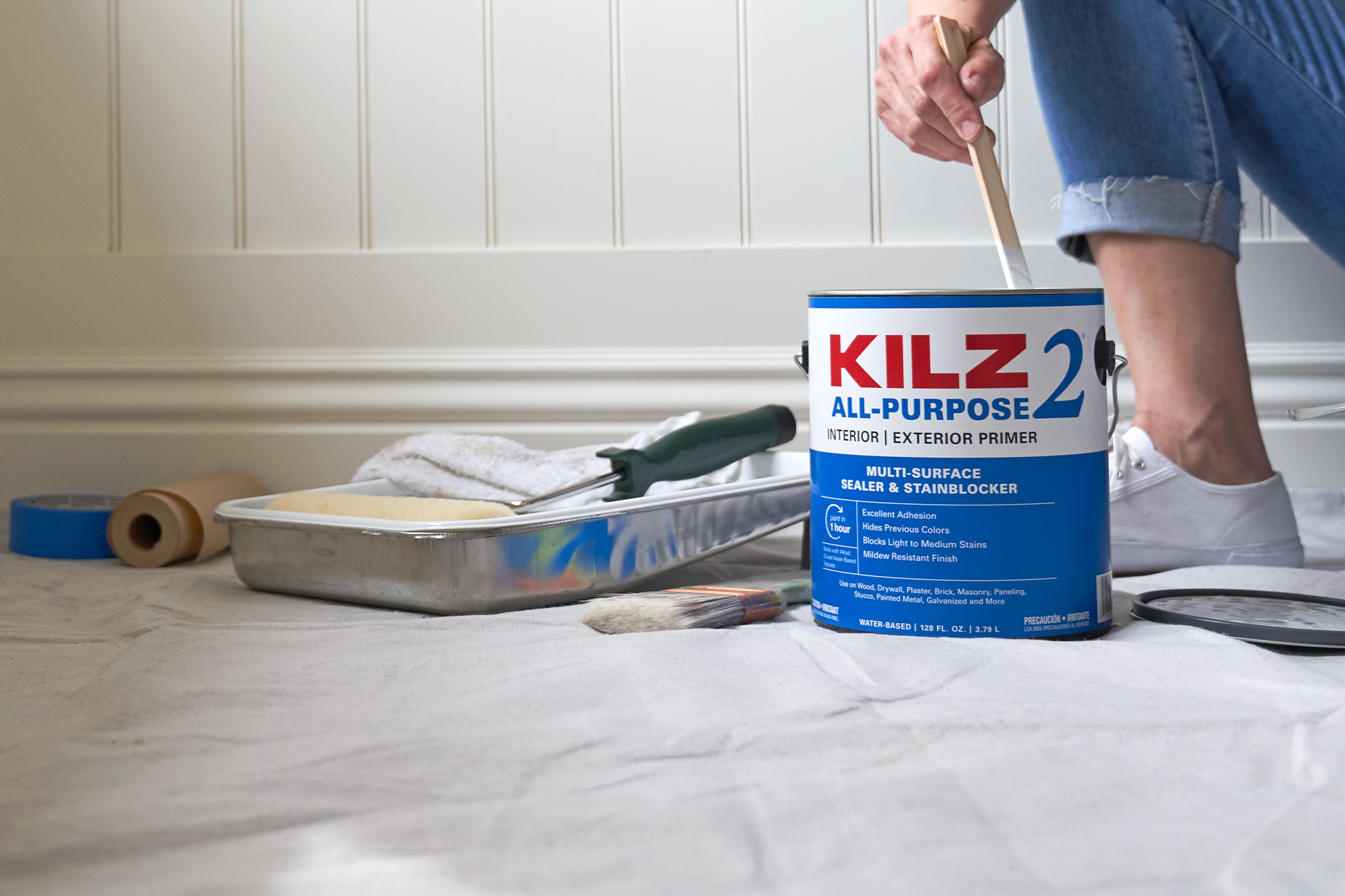
Best of Primer Tips: What Did We Learn This Year?
November 21, 2023To inspire another productive year ahead, let our pro primer tips 2023 recap be your guide. You already know how important a good primer is to any successful painting project, but the finer point may be less clear. That’s why we’re recapping some of the best primer tips of the year and taking a moment to appreciate just how much we learned.
Tip #1: Save time, money, and labor by using primer.
Because it is formulated to solve specific problems before you paint, primer creates an ideal surface for lasting results. This means there’s less likelihood that you’ll have to retouch or redo a project in the short-term. By sealing porous surfaces evenly, for example, you’ll use fewer topcoats, and since primer costs less than the topcoat, using a primer first and then applying the topcoat is cheaper than applying multiple coats of topcoat only.
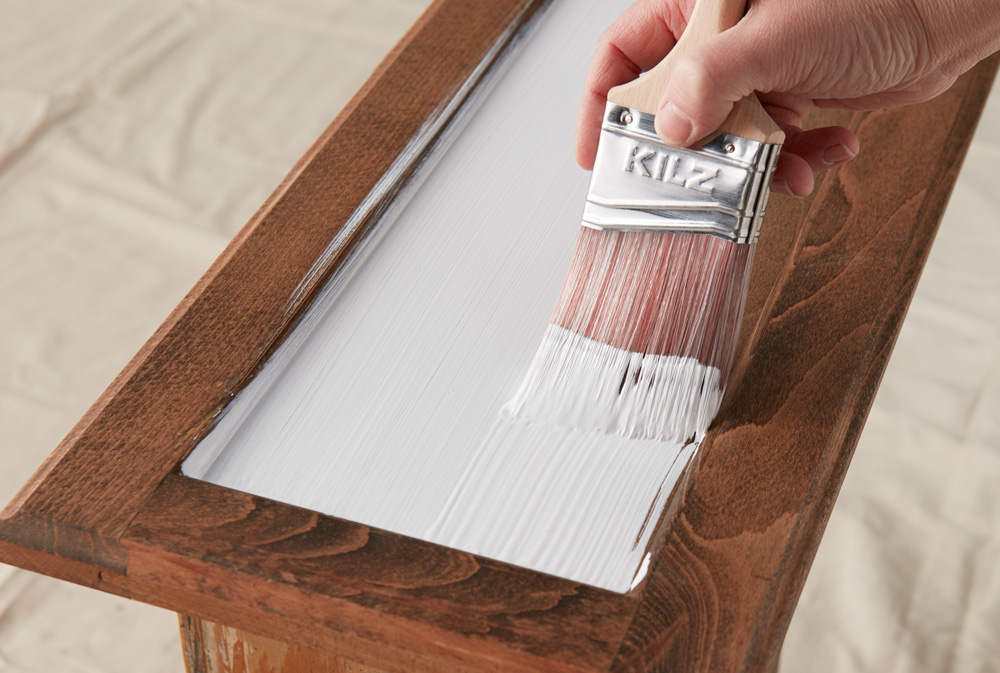
Tip #2: Choose the right primer for your substrate.
Before beginning any painting project, identify the type of surface you want to prime and paint. Different substrates accept coatings differently, which is why KILZ formulated a primer with each surface type in mind. Also take note of your surface’s condition. What circumstances should be addressed before applying a coating? Lastly, identify the environmental conditions where the surface is located. Is it damp? Will it be exposed to weather damage and temperature fluctuations? Each of these conditions dictates the primer and paint you choose to use.
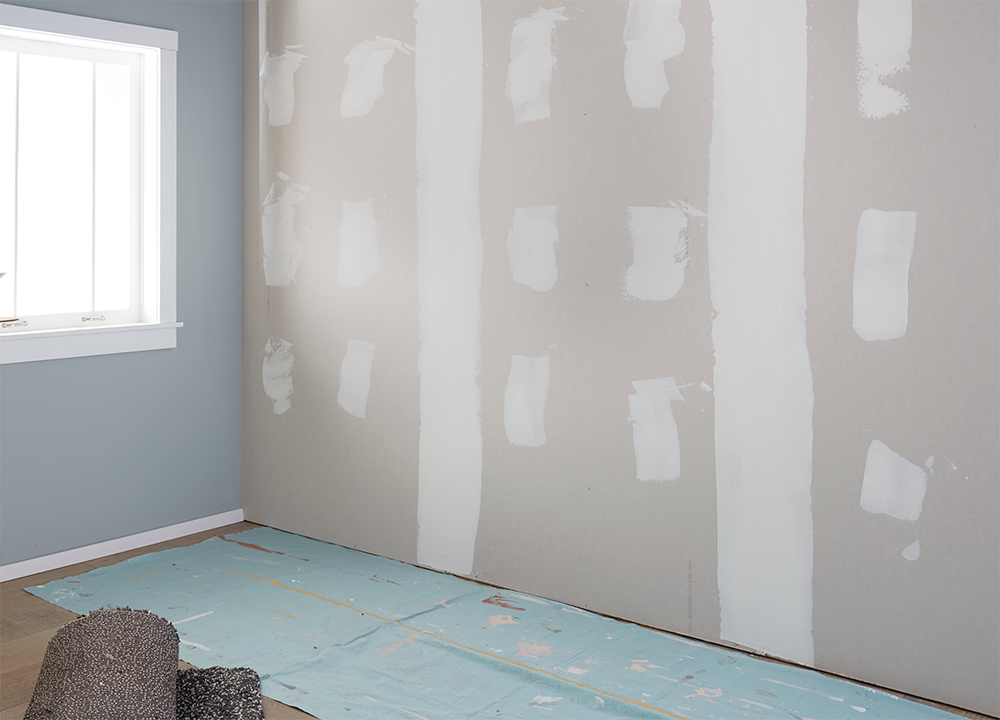
Tip #3: Know your project details ahead of time so you can prepare.
Preparation is key before starting any paint project. You should know the products you’ll need and what steps to follow. For most projects, you can trust a multi-surface primer to prepare the surface for painting, but more complex situations require a specialty formula primer—such as mold, stains, and odors. Preparing for the job beforehand will help things run smoothly from start to finish. Not sure where to start? Review this checklist.
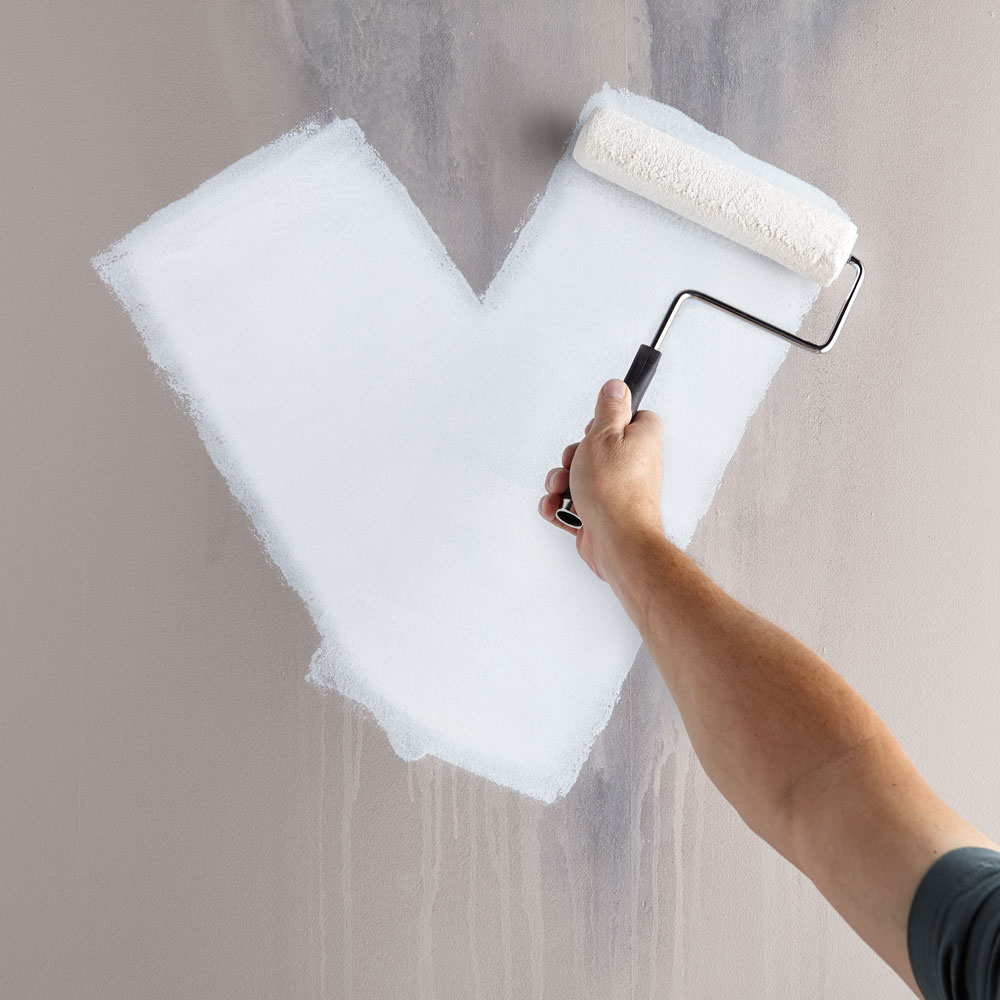
Tip #4: The right application can make a big difference.
Quality usually comes at a higher price than a cheaper alternative, but the results are worth it. Besides selecting a quality applicator, the construction of the applicator should be compatible with the chemistry of the coating being applied. Some brushes are built for water-based products, some are designed to work with oil-based products, and some will work with both. Most rollers are compatible with oil- and water-based products. This information is usually listed on the packaging, so make sure to check for it when choosing an applicator.
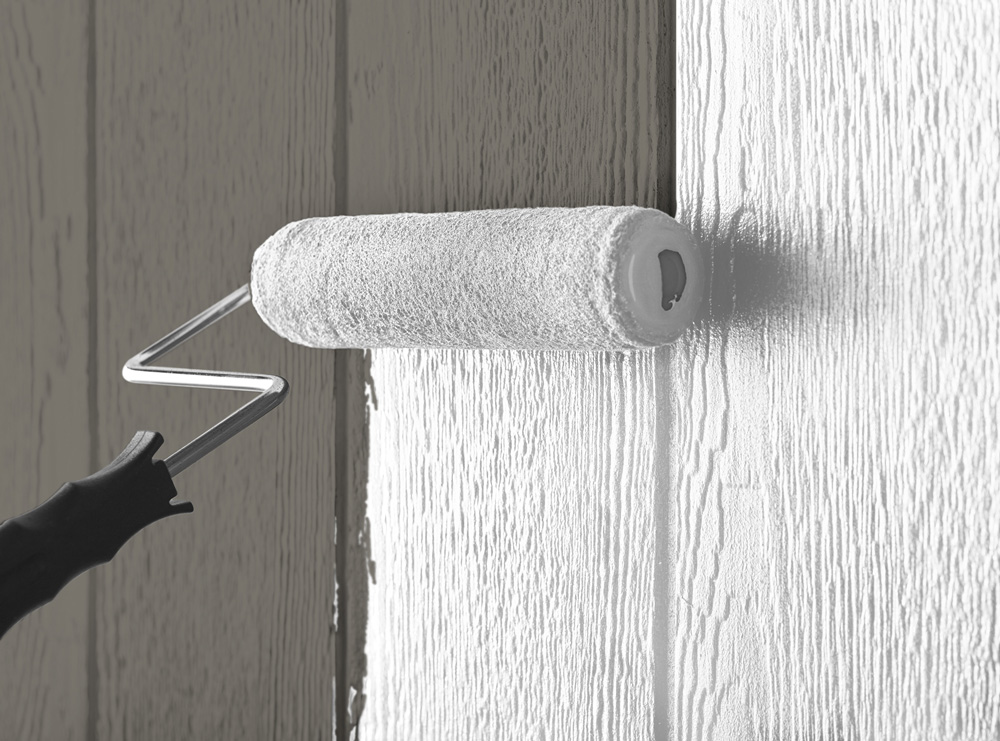
Tip #5: Know when to use primer and when paint & primer in one will work.
The idea of saving time and money by skipping a step in the painting process is appealing, and while many paint and primers in one (PPIO) boast this claim, it’s not always that simple. While it can work for some jobs, more specialized products will give you better results depending on the situation. For example, PPIO can work well on pre-painted surfaces without a drastic change in color or texture, but this is possibly the only reason to choose it. If your job is more complex than that, it’s best to opt for a specialized primer in addition to paint.
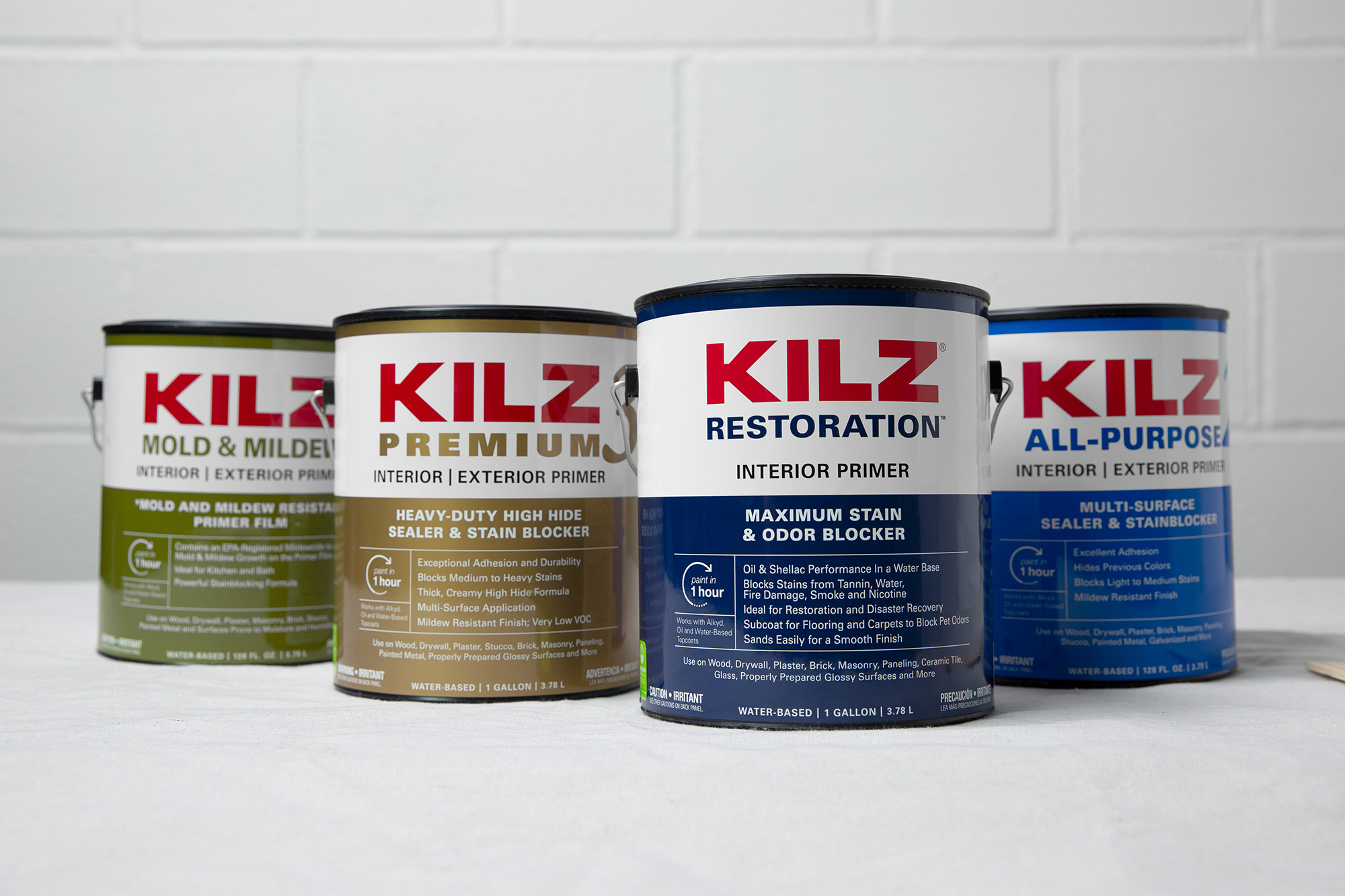
Tip #6: Understand the different types of sheen and choose wisely.
If chosen incorrectly, sheen can amplify surface imperfections, make a surface shinier (or flatter) than intended, or not provide enough durability for the space. Some sheens are easier to clean than others and can provide a barrier against moisture, mildew, and other grime. The darker and richer a paint color is, the more colorant it contains, which boosts sheen. If you’ve chosen a rich or dark paint, and you don’t want it to turn out super shiny, choose one with a lower sheen. In the same vein, if painting a large, sun-washed, or flawed surface, a lower sheen paint is best for hiding imperfections.
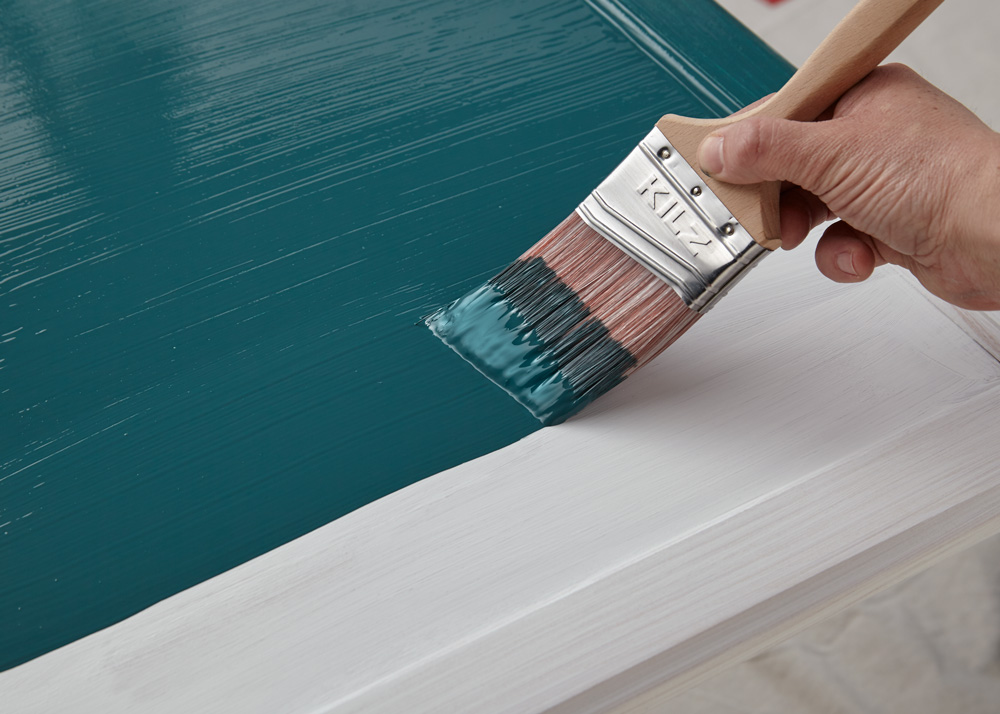
For more helpful tips like these, be sure to check back in with us so that you can tackle all your future projects with confidence. KILZ® Primers are here to make your DIY dreams a success. We hope you had a productive year and can’t wait to see what will inspire you in 2024.
Always remember to refer to our website kilz.com or product back labels for additional information on which primer is right for your project and detailed instructions on how to apply our products. Check out our Coverage Calculator to understand your estimated paint needs for your upcoming project.
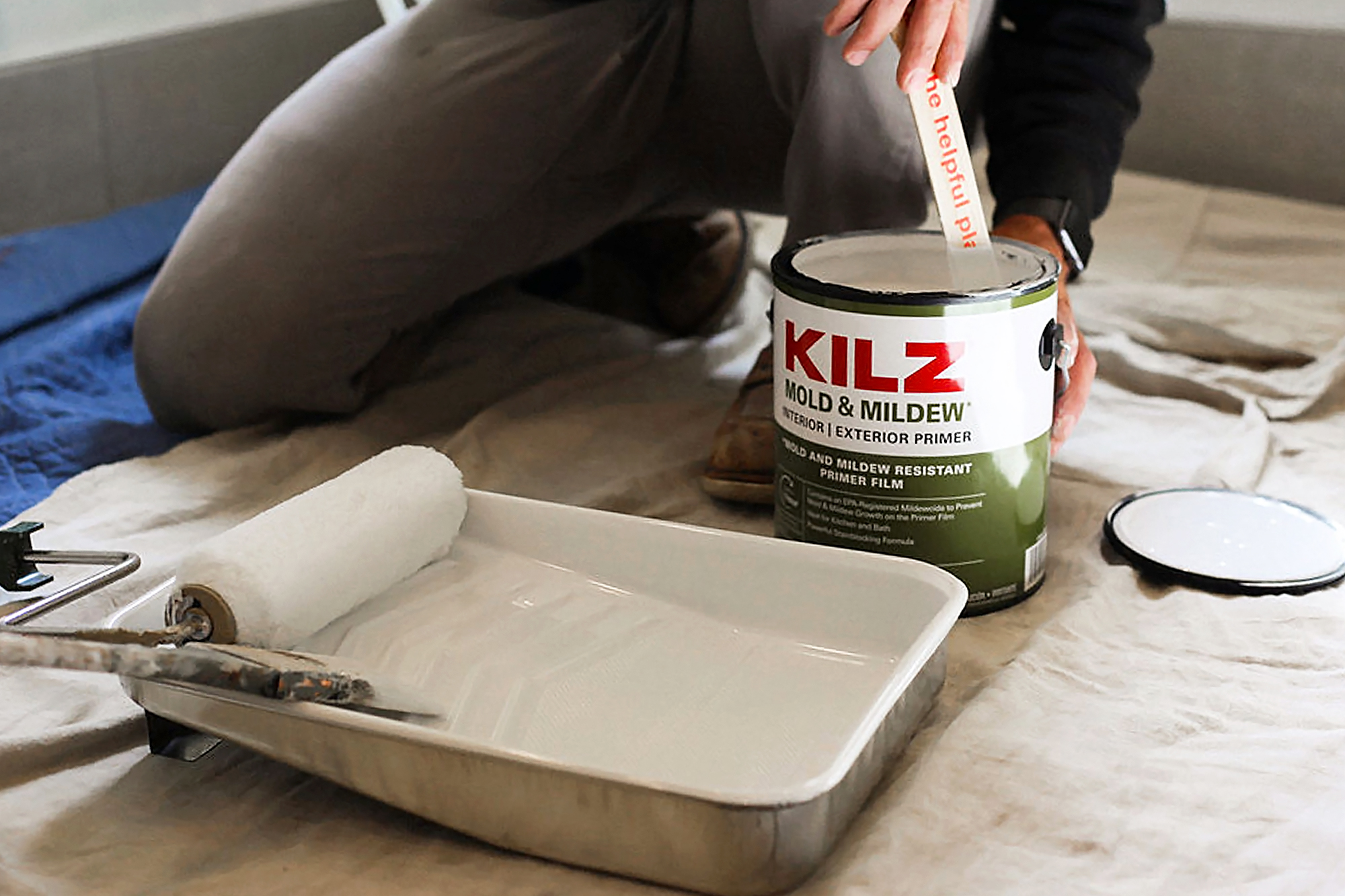
Project Spotlight: A Bathroom Remodel With KILZ® Primers – Part 1
November 20, 2023We are Jamie and Morgan Molitor, a dynamic duo in both life and business, and the driving force behind our journey in home remodeling, interior styling, and the world of small media. Since 2012, we’ve been all about keeping it real.
What started as a lifestyle blog has since blossomed into c2s, a thriving design and build business combined with a small media enterprise. With over a decade of experience, we’ve mastered the art of transforming houses and crafting spaces filled with joy, not only for our clients but for ourselves as well. We’re here to take you on a journey through every step, from design and construction processes to the intricacies of digital marketing.
Our most recent bathroom design and remodel project is in Wayzata, MN for the fabulous Chris Freytag, a local health and fitness expert, blogger, author, and popular keynote speaker here in the Twin Cities.
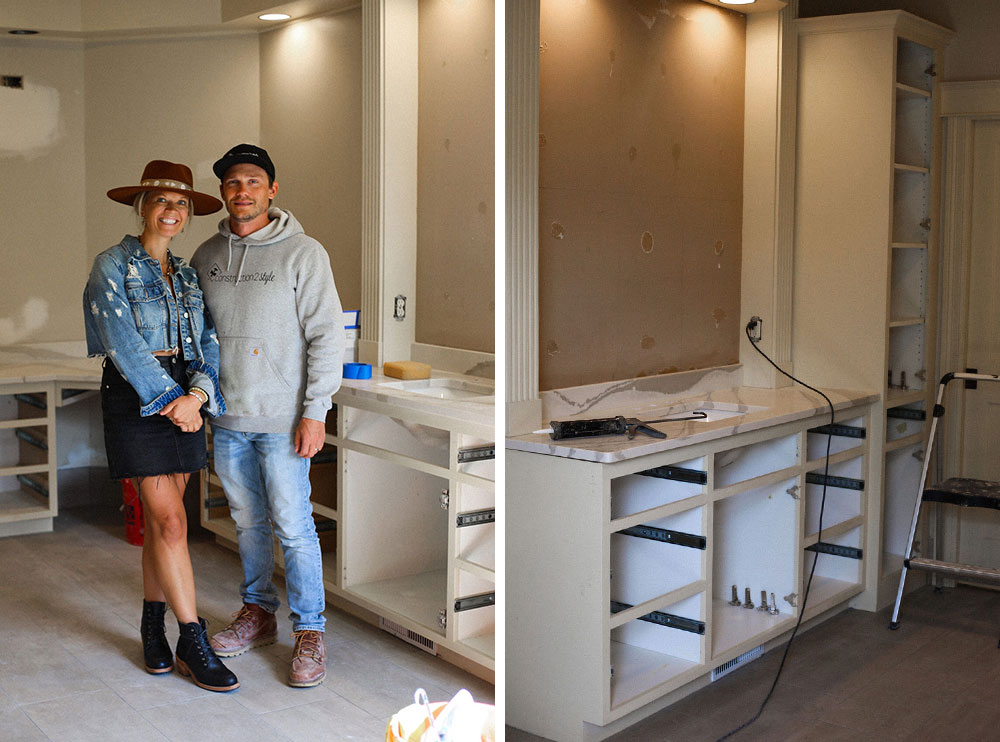
At our core, we have a genuine passion for remodeling primary bathrooms, and there’s a unique excitement when we embark on a total transformation while preserving the existing layout. It’s like unlocking the hidden potential within the familiar confines. Each year, we take on approximately 10 bathroom projects that follow this transformative approach, where we breathe new life into the space without altering its fundamental structure. There’s an art to retaining the essence of the layout while infusing it with modern elegance and functionality. It’s about enhancing the existing beauty, ensuring that every corner reflects the homeowner’s vision, and delivering a space that feels both rejuvenating and utterly luxurious. These projects allow us to showcase our expertise and creativity, creating bathrooms that are not just functional but also awe-inspiring havens within the home.
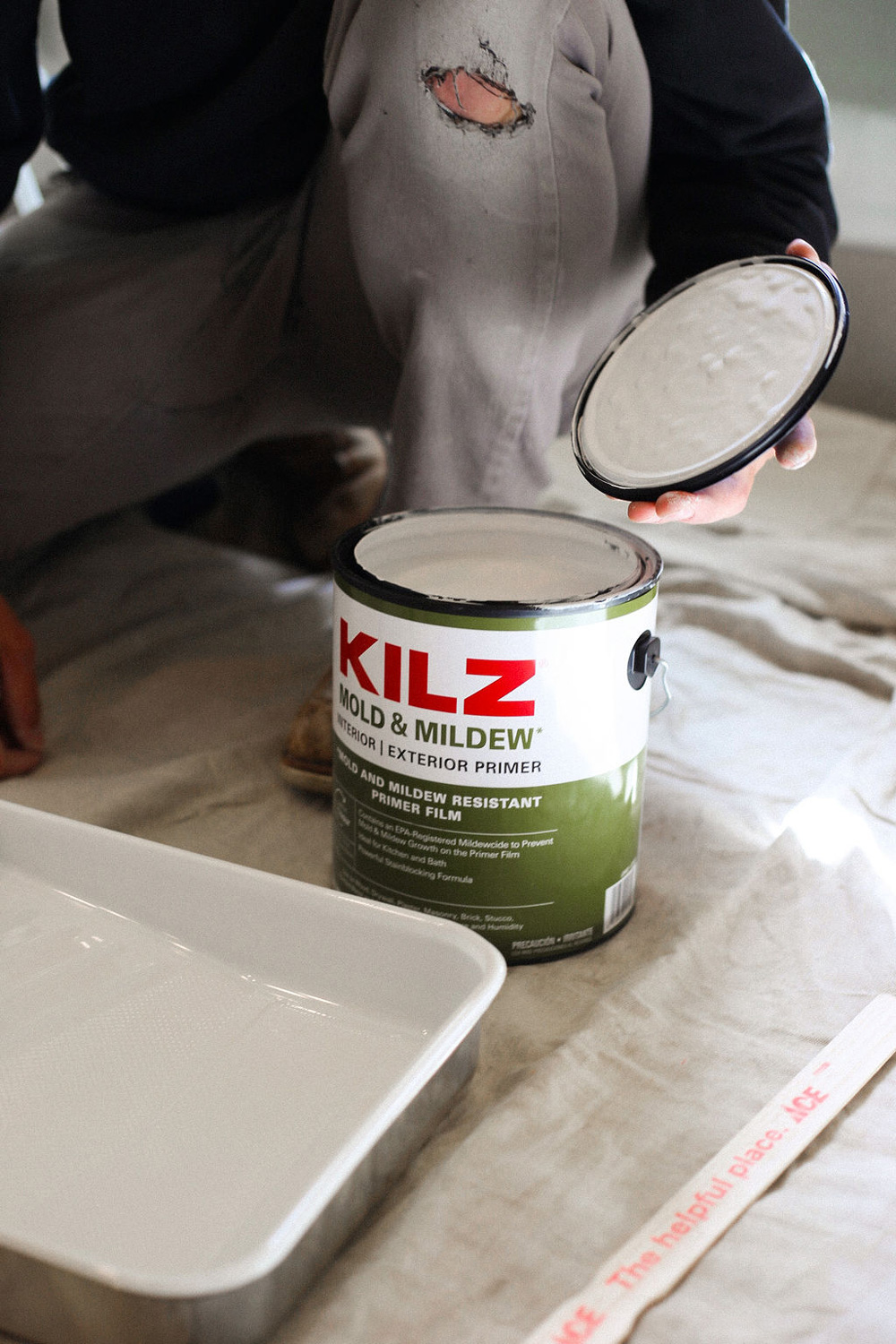 And one of the best ways to do this is through paint! The KILZ® brand is one of c2s’ go-to brands, especially for bathroom remodels. In high-humidity areas, such as bathrooms, finding the right primer that can withstand moisture is crucial. That’s where KILZ® MOLD & MILDEW Primer truly shines. Specially designed for these challenging environments, it forms a protective barrier that not only prevents mildew growth but also supports the paint, ensuring it thrives in its best condition. With KILZ® MOLD & MILDEW Primer, you can confidently transform your spaces, knowing that your paint will stand strong against the challenges of high humidity, allowing your home to look its best for years to come. Say goodbye to worries and hello to enduring, vibrant walls!
And one of the best ways to do this is through paint! The KILZ® brand is one of c2s’ go-to brands, especially for bathroom remodels. In high-humidity areas, such as bathrooms, finding the right primer that can withstand moisture is crucial. That’s where KILZ® MOLD & MILDEW Primer truly shines. Specially designed for these challenging environments, it forms a protective barrier that not only prevents mildew growth but also supports the paint, ensuring it thrives in its best condition. With KILZ® MOLD & MILDEW Primer, you can confidently transform your spaces, knowing that your paint will stand strong against the challenges of high humidity, allowing your home to look its best for years to come. Say goodbye to worries and hello to enduring, vibrant walls!
THE PROJECT
At first, Chris and her husband aimed for a cosmetic refresh since the space’s layout was already well-designed. Removing the jetted tub was a priority, and the only structural change involved expanding the shower entrance. Everything, except the cabinetry, underwent a transformation — from paint and countertops to tiles and fixtures. A complete makeover to match their vision! The whole goal of this project was to say goodbye to the beige and hello to white, white, white. A light and bright bathroom makeover!
A classic bathroom remodel is like a timeless makeover that keeps things stylish and comfy. It’s all about simple lines, cool fixtures, and a calming color scheme that makes your bathroom a chill space to be in. Think subway tiles, vintage tubs, and those shiny chrome fixtures you love. Classic bathrooms never go out of style and give you a space that’s not just pretty but also super practical. Whether it’s the retro vibes of black and white or the cozy feel of wood accents, classic bathroom makeovers keep things cool and comfy for years to come.
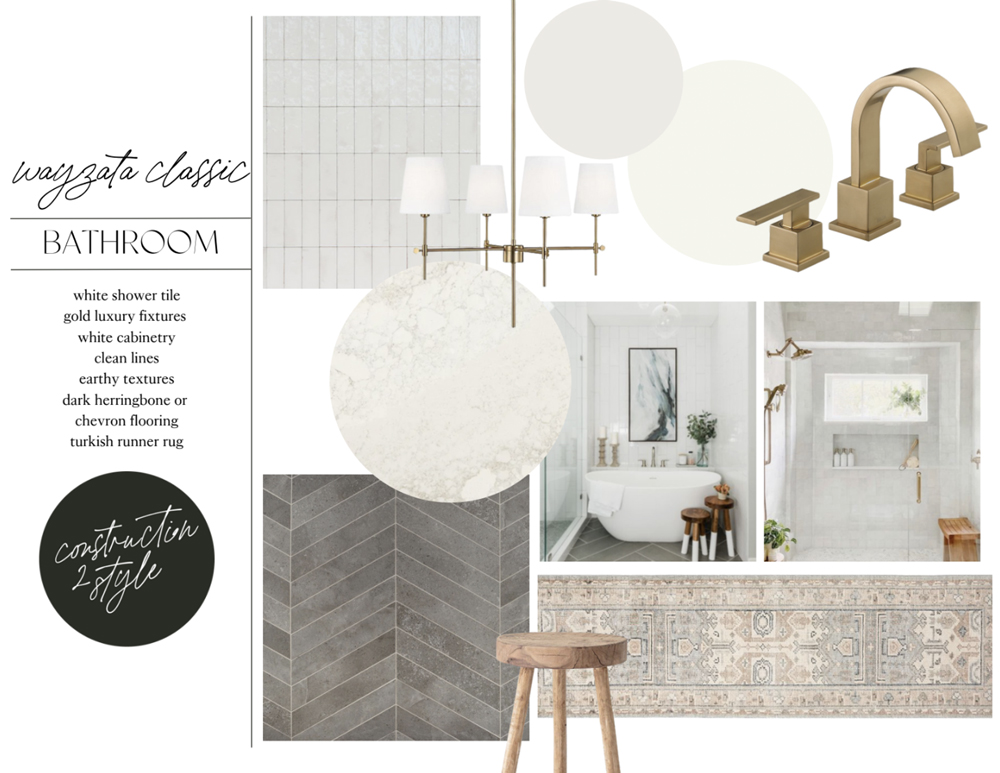
This project has been smooth sailing. Painting is underway, plumbing up next – and this project will be a wrap! Can’t wait to share the final reveal with you all soon. But today – we wanted to chat about priming and painting! Especially the importance of primer, something that is so often overlooked. We see so often those buying the cheapest primer or even worse, not priming at all. Once you get done reading this blog post – we hope you will never be that person.
Importance of Primer
Priming is like the secret sauce for a successful paint job. It’s the difference between just getting it done and getting it done perfectly, ready for Instagram-worthy photos. Taking the time to prime is a smart move that can save you time and money down the road. With KILZ® Primers, you can achieve long-lasting results that you can show off with confidence. These go-to products always deliver the dependable and consistent performance you need.
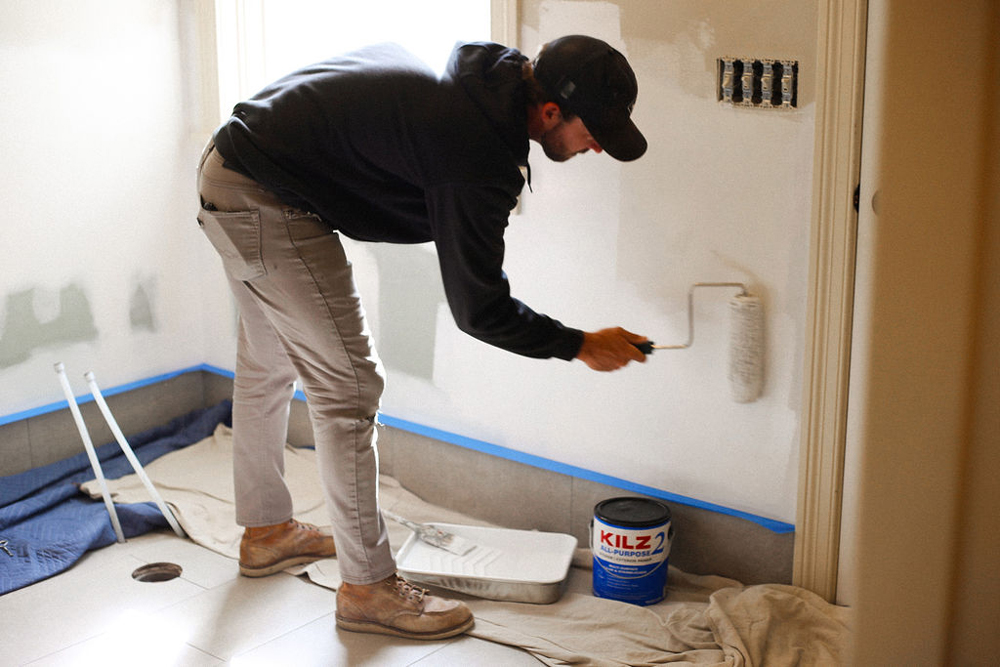
Our Go-To KILZ Products
These are c2s’ four go-to primers when it comes to any project beyond this bathroom renovation. And we’re here to tell you the differences between them and why we love and use them.
KILZ® MOLD & MILDEW Primer is your go-to solution for residential spaces that deal with high humidity, moisture, and temperature fluctuations, like kitchens, bathrooms, powder rooms, and laundry rooms. This water-based primer-sealer-stain blocker offers excellent adhesion on both indoor and outdoor surfaces, providing a solid base for paints to adhere to. What sets it apart is its EPA-registered ingredient, which forms a protective, mold and mildew-resistant layer on the primer surface, keeping these unwelcome guests at bay. It’s also a champ at blocking medium to heavy stains like markers, grease, ink, and more. Plus, it dries quickly, has a mild odor, has low VOCs, and can be easily cleaned up with soap and water.
KILZ RESTORATION® Primer is like a modern superhero for your home surfaces. It’s a water-based primer, sealer, and stain blocker that rivals the performance of traditional oil and shellac-based primers. This powerhouse takes on the toughest stains, from water damage and rust to smoke, nicotine, ink, and even pesky pet stains. But it doesn’t stop there—KILZ RESTORATION® Primer is also your go-to solution for sealing in persistent odors like those from pets, food, and smoke. You can use it on a variety of indoor surfaces, from drywall and woodwork to plaster, masonry, and even glossy surfaces. It’s the perfect base for water-based or oil-based paint, and it’s a game-changer when you’re replacing carpet or wood flooring and need to block subfloor odors. Say hello to your home’s new best friend!
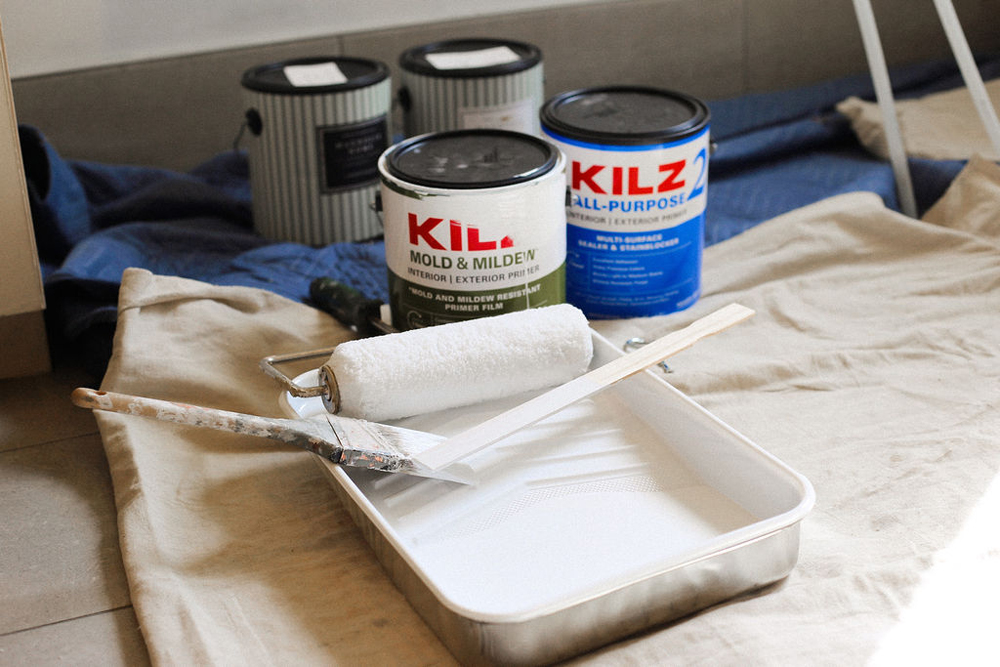
KILZ 2® ALL-PURPOSE Primer is your speedy, go-to solution for priming, sealing, and blocking stains on a variety of surfaces. This water-based wonder is known for its quick-drying, excellent adhesion, and mildew-resistant properties, all while emitting a very faint odor. It’s your trusty partner in blocking medium stains, such as minor water stains, rust, ink, and more, and it’s especially handy when you’re changing colors, reducing the need for multiple paint coats. Suitable for both indoor and outdoor surfaces like woodwork, drywall, masonry, and even glossy surfaces with proper preparation. You can confidently use it under or over water-based or oil-based paints.
KILZ 3® PREMIUM Primer is a top-notch, quick-drying, and low-odor water-based primer-sealer-stain blocker. It’s got a very low VOC, making it environmentally friendly, and it excels in adhesion while providing a protective, mildew-resistant coating—perfect for areas prone to moisture. This powerhouse can tackle medium to heavy stains caused by water, tannin, ink, grease, and more. With its thicker, high-hiding formula, it’s a champ at concealing surface imperfections and prepping your surfaces for a fresh coat of paint. From indoor to outdoor projects, it’s versatile and suitable for woodwork, drywall, masonry, and even glossy surfaces with proper prep. Plus, it plays well with both oil and water-based paints.
We hope you enjoyed learning about our progress, and more is to come! We are waiting on a final light and the shower glass door and then this project will be a wrap. Stay tuned for the big reveal – before and after coming to KILZ’s The Perfect Finish blog soon!
*This is a sponsored blog post with c2s.
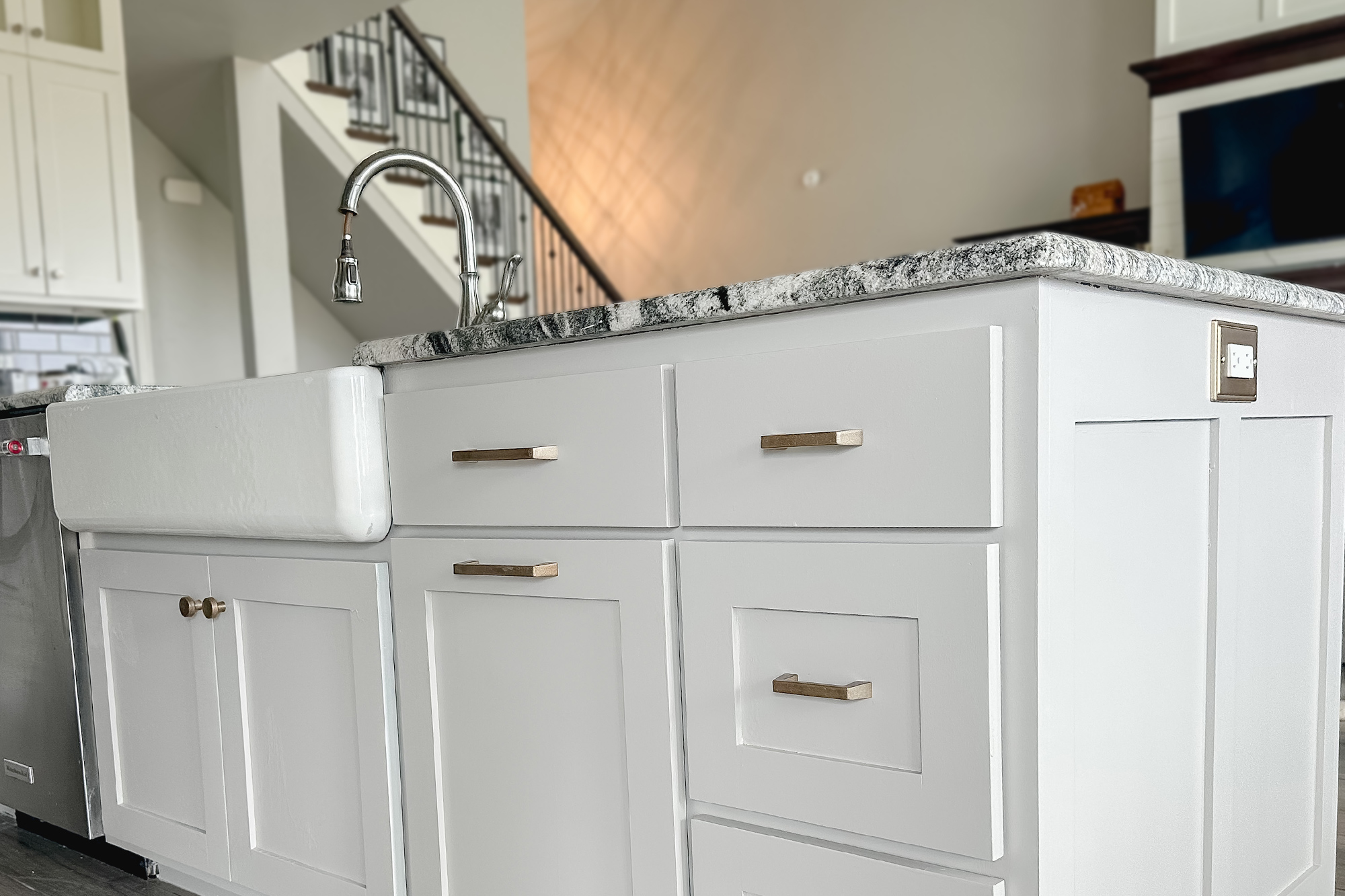
Project Spotlight: A Step-by-Step Guide to Painting Your Kitchen Cabinets
November 1, 2023Hi! My name is Abby from Making It With Abby. I am a self-taught DIYer who loves to learn new things and take on all sorts of different projects. I find so much joy in creating with my own two hands and teaching others how they can do it too! As a new homeowner, I started building furniture, but it wasn’t until 7 years later that I started taking on other types of home projects, which is when Making It With Abby was born!
When we built our second home 7 years ago, I didn’t have a strong design sense or style, so when my builder suggested a dark gray/brown stain for our kitchen island, I agreed. I never really liked it and especially disliked how much dirt it showed. I recently renovated our dining area, and it left our island looking out of place. I started thinking about painting it to better fit the space and be a color I actually love.
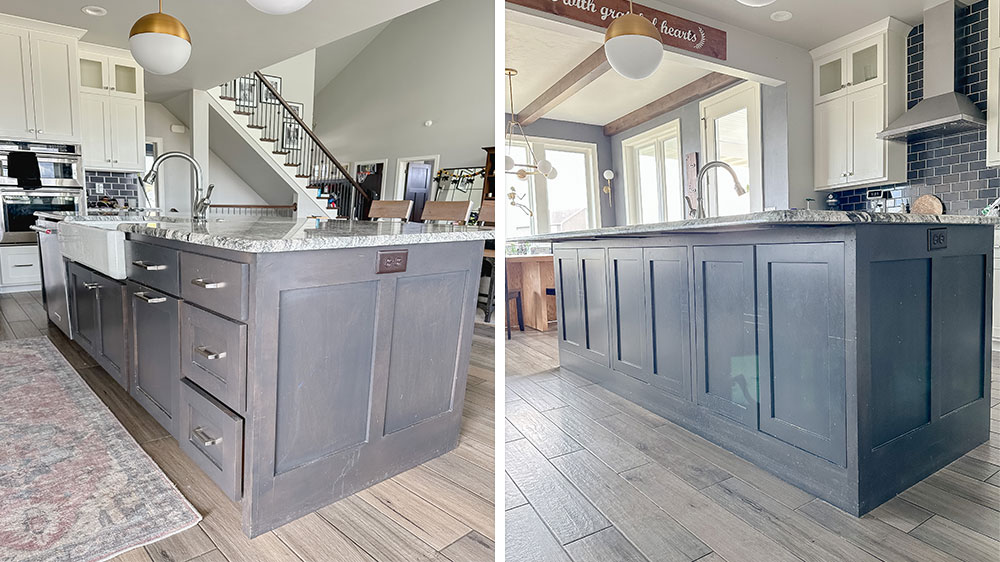
I think a lot of people are in the same boat and don’t like the color of their cabinets, or their cabinets just need a fresh coat of paint. It may seem daunting to think about painting your kitchen cabinets or an island, but it is actually very simple. Best of all, painting your cabinets can breathe new life into your kitchen, giving it a fresh and updated look. In this tutorial, I’ll take you through the entire process using KILZ 3® PREMIUM Primer, ensuring a durable and beautiful finish that will stand up to the demands of a high-traffic kitchen. Let’s get started!
Step 1: Prepare Your Cabinets
The first step in this cabinet transformation journey is preparation. To do this, you’ll need to:
• Remove Decorative Hardware: Begin by taking off all the hardware from your cabinets. Place screws, hinges, and other small parts in a secure place to ensure you don’t lose any.
• Remove Cabinet Doors: Carefully remove the cabinet doors so you have easy access to the cabinet frames for painting. I also removed the hinges where it was blocking areas that needed to be painted, but the other hinges just needed to be covered with painter’s tape.
Step 2: Clean and Degrease
Before applying any primer or paint, it’s important to clean your cabinets thoroughly to remove dirt and grease buildup. Use a degreaser to cut through kitchen grime, ensuring a clean surface for the products.
Step 3: Scuff Sand the Cabinets
To improve paint adhesion, lightly scuff sand the cabinet surfaces. This step removes any sheen and provides a better grip for the primer. I recommend using 150 or 180 grit sandpaper.
Step 4: Wipe Down the Cabinets
After sanding, wipe down the cabinets with a damp cloth to remove any dust and residue from sanding. A clean surface is essential for a smooth finish.
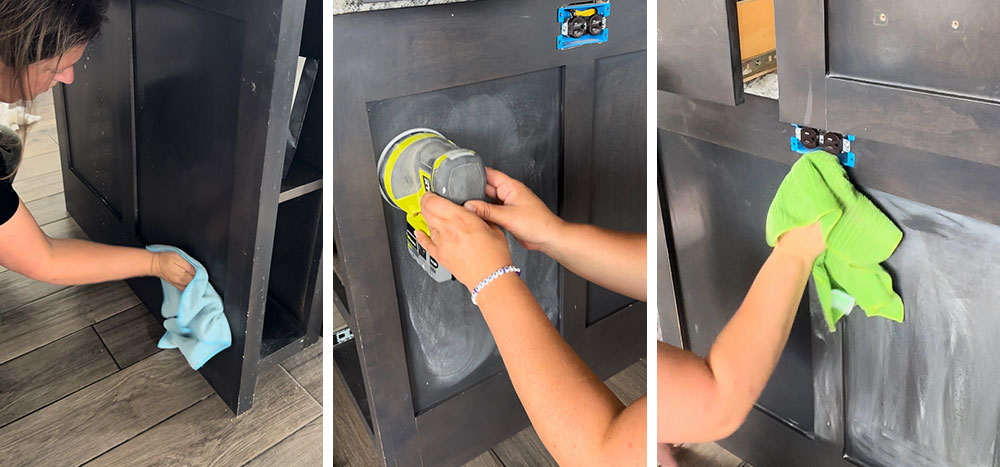
Step 5: Primer Application
Priming is a crucial step in cabinet painting, especially in a high-traffic area like a kitchen. It makes all the difference between a job done and a job done correctly. I selected KILZ 3® PREMIUM Primer because it provides excellent adhesion to prevent any paint chipping or peeling in the future, and the mildew-resistant coating prevents any mildew growth in moisture-prone areas like a kitchen. There is nothing worse than fixing your old mistake; using a primer helps ensure that this job is done right the first time. KILZ 3® PREMIUM Primer was also the best choice for my project because it provides coverage for medium-to-heavy stains, which will ensure that the current dark color of my island doesn’t bleed through the paint.
Apply a uniform coat of KILZ 3® PREMIUM Primer to your cabinet frames and doors. The thicker formula fills in imperfections in the wood grain of your cabinets, creating a smooth surface for paint application.
I used a brush to get into corners and crevices and a mini foam roller on the rest of the surface and to cover any visible brush strokes. I find a mini foam roller gives the best and smoothest finish when painting cabinets or furniture without the use of a paint sprayer. I decided to use my paint sprayer on the cabinet doors, but you can definitely use a brush and roller for the doors as well.
Using a paint sprayer may seem intimidating, but it’s really quite easy to use. I like to use an airless sprayer, and it really is as simple as pulling the trigger and moving in a slow, even motion. I have used a few different kinds of sprayers at all different price points, and all have been easy to use and have given an impeccable finish.
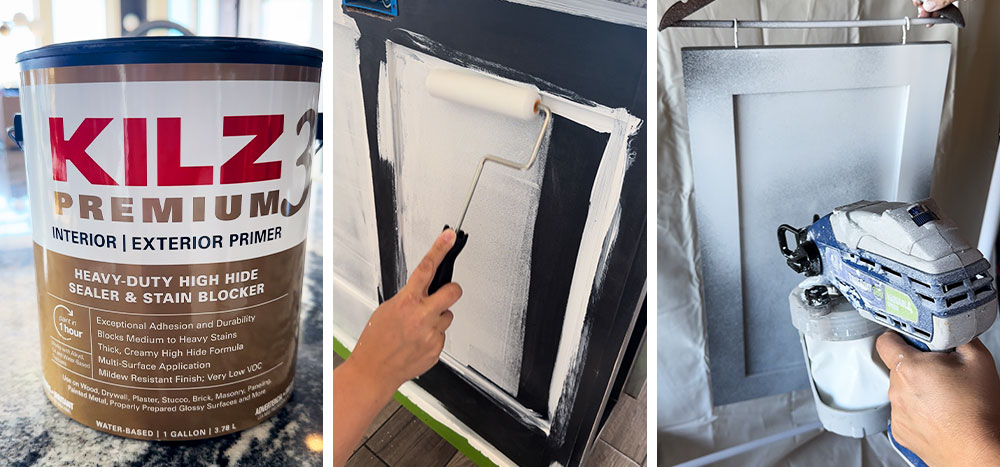
Step 6: Sand and Wipe Down Again
KILZ 3® PREMIUM Primer is ready for paint in just one hour. After the primer has dried, lightly sand the surfaces once more to ensure a smooth finish. Be sure to remove any dust with a tack cloth or damp cloth.
Step 7: Paint Your Cabinets
For the paint, I used Magnolia Home by Joanna Gaines® Cabinetry and Furniture Paint. Choose a color that suits your kitchen’s style. There are so many gorgeous colors to choose from in the Magnolia Home by Joanna Gaines® Paint line, but I decided on the color Anatolian, a perfect warm tan with gray undertones. I love this line of paint because of the perfectly curated color options and the superior durability and stain resistance. Their cabinetry and furniture paint offers superior flow and self-leveling which is crucial when painting cabinets to get a smooth and sleek finish.
Apply the paint in even, thin coats to achieve a sleek and professional finish. Be sure to allow each coat to dry thoroughly before applying the next. Once again, I used a brush for corners and crevices and then went over the surfaces with a mini foam roller.
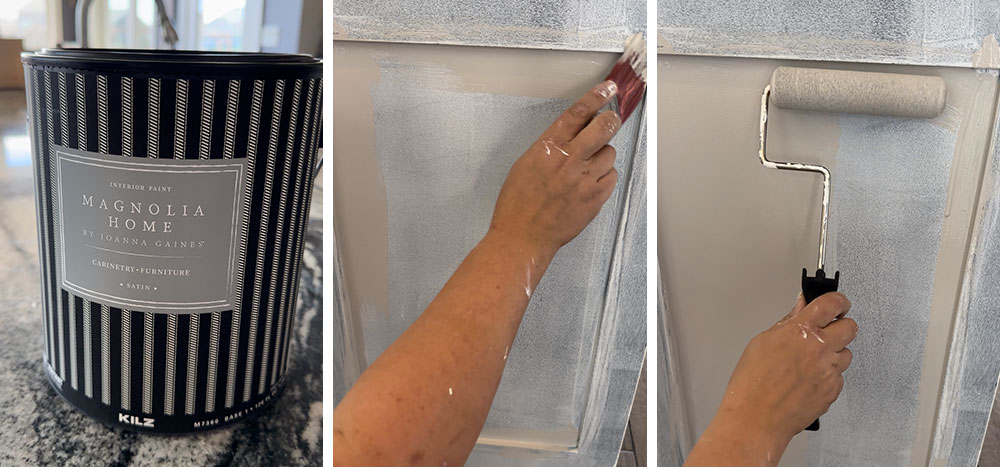
Step 8: Sand and Wipe Down Between Coats
Between coats of paint, lightly sand the surfaces again and remove any dust with a tack cloth or damp rag. This step ensures a flawless finish.
Step 9: Hardware Upgrade
After painting the cabinets, you might want to also update the hardware for a complete transformation. I used KILZ® ORIGINAL Aerosol to prime the metal hardware and then BEHR PREMIUM™ Metallic Spray Paint to give it a fresh, new look. This small change can make a significant impact on the overall look of your kitchen.
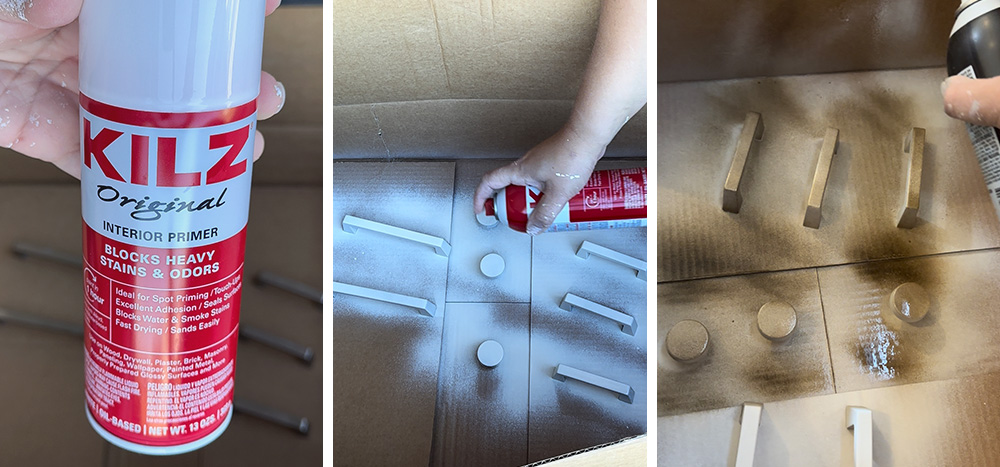
Step 10: Reinstall Hardware and Cabinet Doors
Once everything is dry, reinstall the hardware onto your newly painted cabinet doors, and then reinstall the doors to the cabinet frames. Painting your kitchen cabinets can be a rewarding DIY project that transforms your kitchen’s appearance. By following these steps and using KILZ 3® PREMIUM Primer and Magnolia Home by Joanna Gaines® Cabinetry and Furniture Paint, you’ll achieve a beautiful, durable finish that will make your kitchen feel like new. Enjoy your freshly updated space!
*This post is a paid partnership with Making It With Abby.
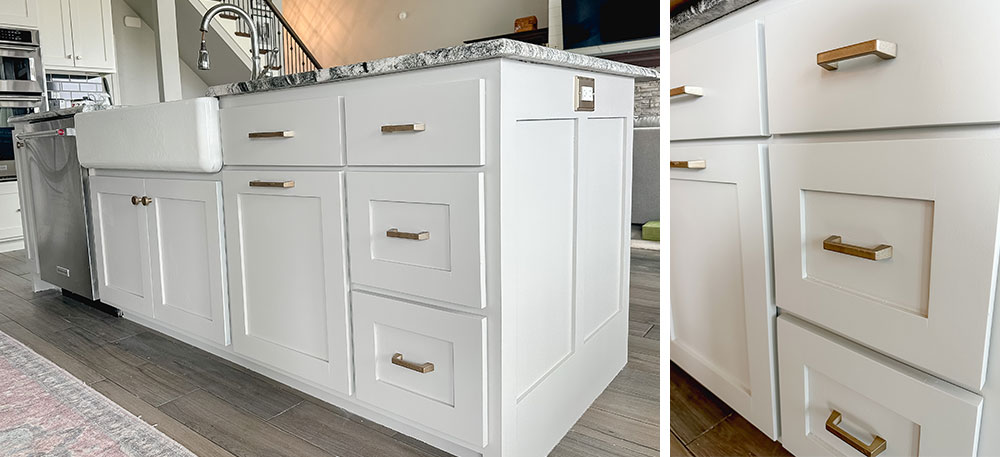
Always remember to refer to our website kilz.com or product back labels for additional information on which primer is right for your project and detailed instructions on how to apply our products. Check out our Coverage Calculator to understand your estimated paint needs for your upcoming project.

What’s Really in the Can? Primer vs Paint & Primer in One
June 29, 2023Primer vs. Paint and Primer: Can All-in-One Do It All?
If you can skip a step in the painting process and still get the same results, it seems like a no-brainer. Many paint and primer in one (PPIO) products boast this claim, but should you always combine these steps and skip using a separate primer?
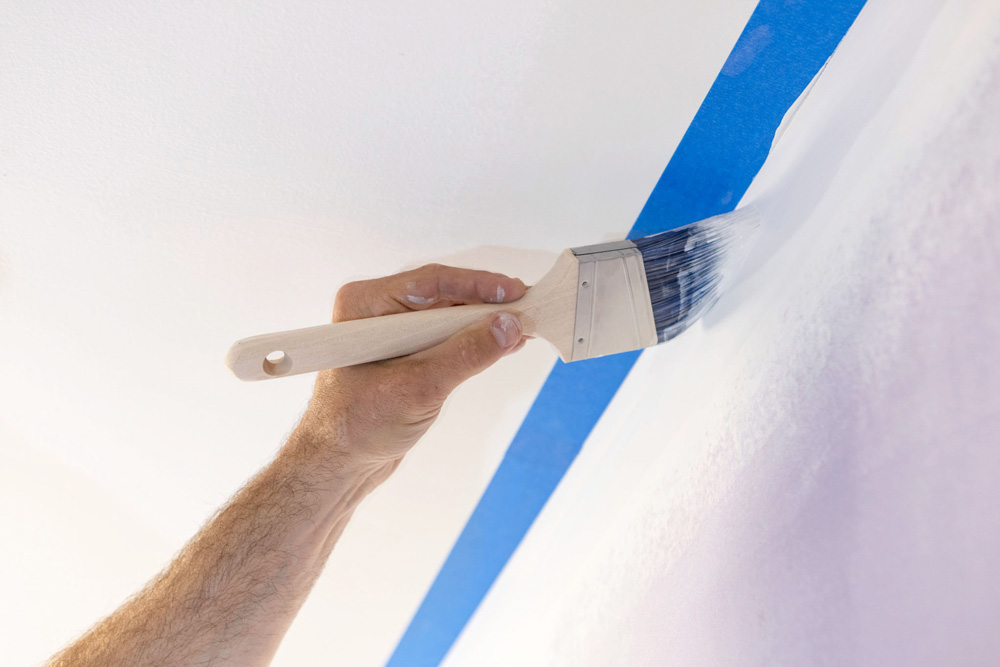
When to Choose a Self-Priming Paint
The benefit to using PPIO is that you can achieve similar results in less time. However, there are some things to know before you choose to go this route.
PPIO can work for some jobs, but different products will give you better results depending on the situation. For example, PPIO can work well on pre-painted surfaces without a drastic change in color or texture. However, this is possibly the only reason to choose it.
Why You Should Prime Separately
The goal of any primer is to prepare the surface for a coat of paint. This ensures good adhesion to the substrate and the topcoat. You may also need to block stains and odors, protect walls from mold or mildew growth, change the color, or refresh an old or damaged surface. Be mindful of the nature of your job before deciding to forgo primer as a first step, as it is often explicitly formulated to alleviate many of these surface problems, whereas an all-in-one product is typically not.
When to Choose a Primer
Suppose a surface has never been painted, as with drywall, a traditional primer is a must. If painting a glossy surface with less glossy paint, priming beforehand will ensure adhesion, and your results remain uniform. Priming separately is essential if painting over oil-based paint with acrylic or latex.
Other cases that require a primer before paint include:
• Any bare surface
• Porous surfaces
• Raw, unfinished wood
• Knotty wood
• Woods with tannins – like Cedar or Redwood
• Uncoated metal
• Unfinished drywall
• Masonry
• Stained surfaces
• Slick surfaces – like tile or laminate
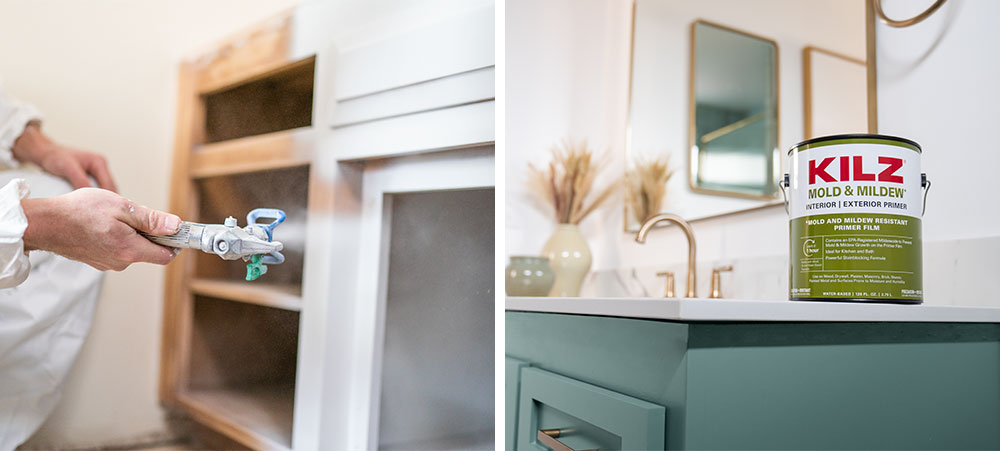
Summary
Whether you choose to go the all-in-one route or choose a separate primer and paint, choosing high-quality products suited for your surface’s condition is crucial. KILZ® primers are formulated for your specific surface issues, such as KILZ RESTORATION® to block tough stains like water damage or KILZ® MOLD & MILDEW to create a mold and mildew-resistant film for use in high-humidity rooms. KILZ 3® PREMIUM is designed to have a thicker formula to improve customer experience and hide. No matter the surface, you can be sure there’s a primer formulated for the job. When you consider how much time and money you invest in your project, choosing the best quality products from the start makes all the difference.
Come back for more tips, tricks, and inspiration, and as always, happy DIY-ing.
Refer to our website, kilz.com, or product back labels for additional information on which primer is right for your project and detailed instructions on applying our products. Check out our Coverage Calculator to understand your estimated paint needs for your upcoming project.
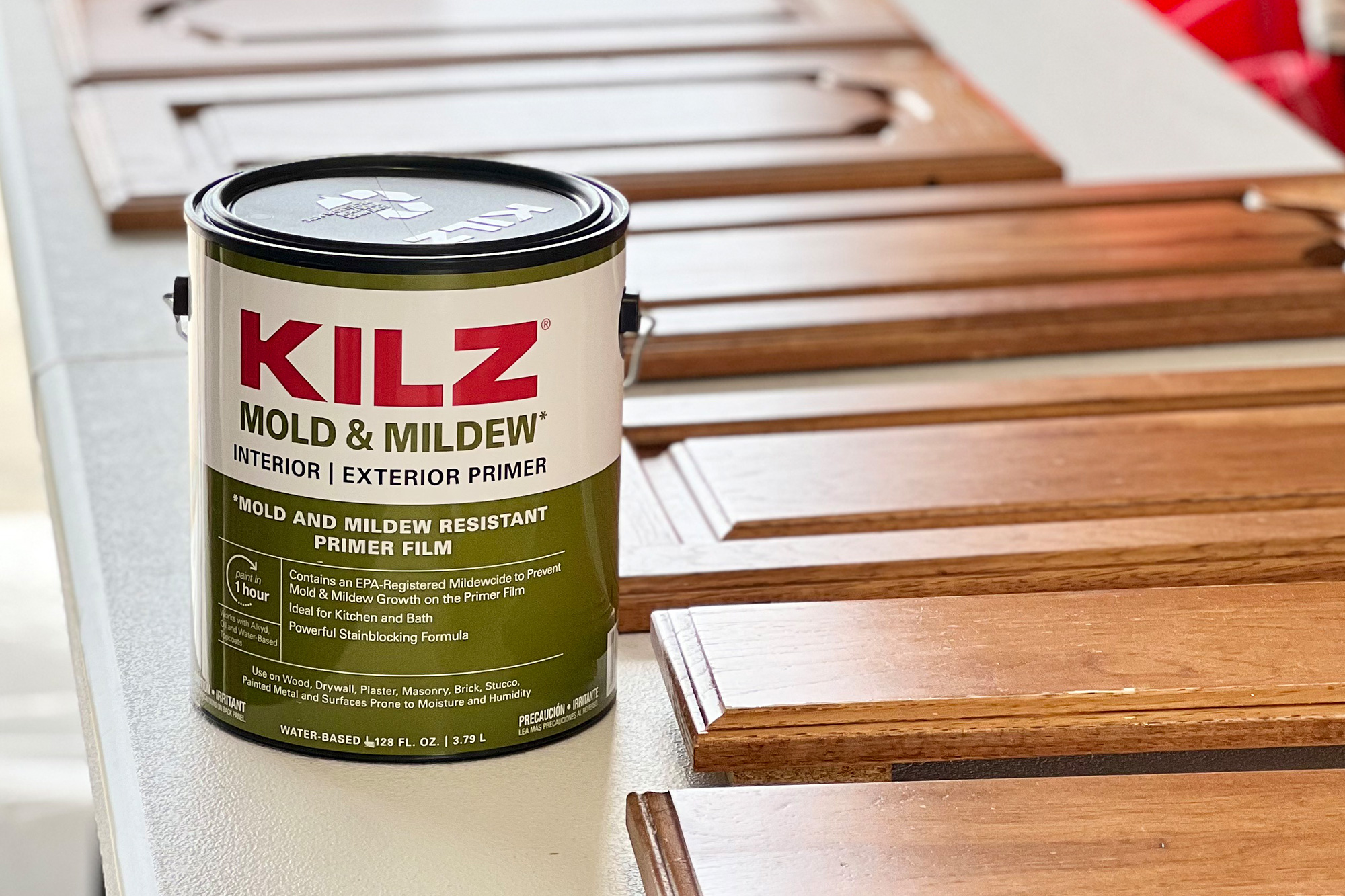
Pro Spotlight: Update Bathroom Cabinets with Britney Mroczkowski of Build It Brit, Inc.
May 31, 2023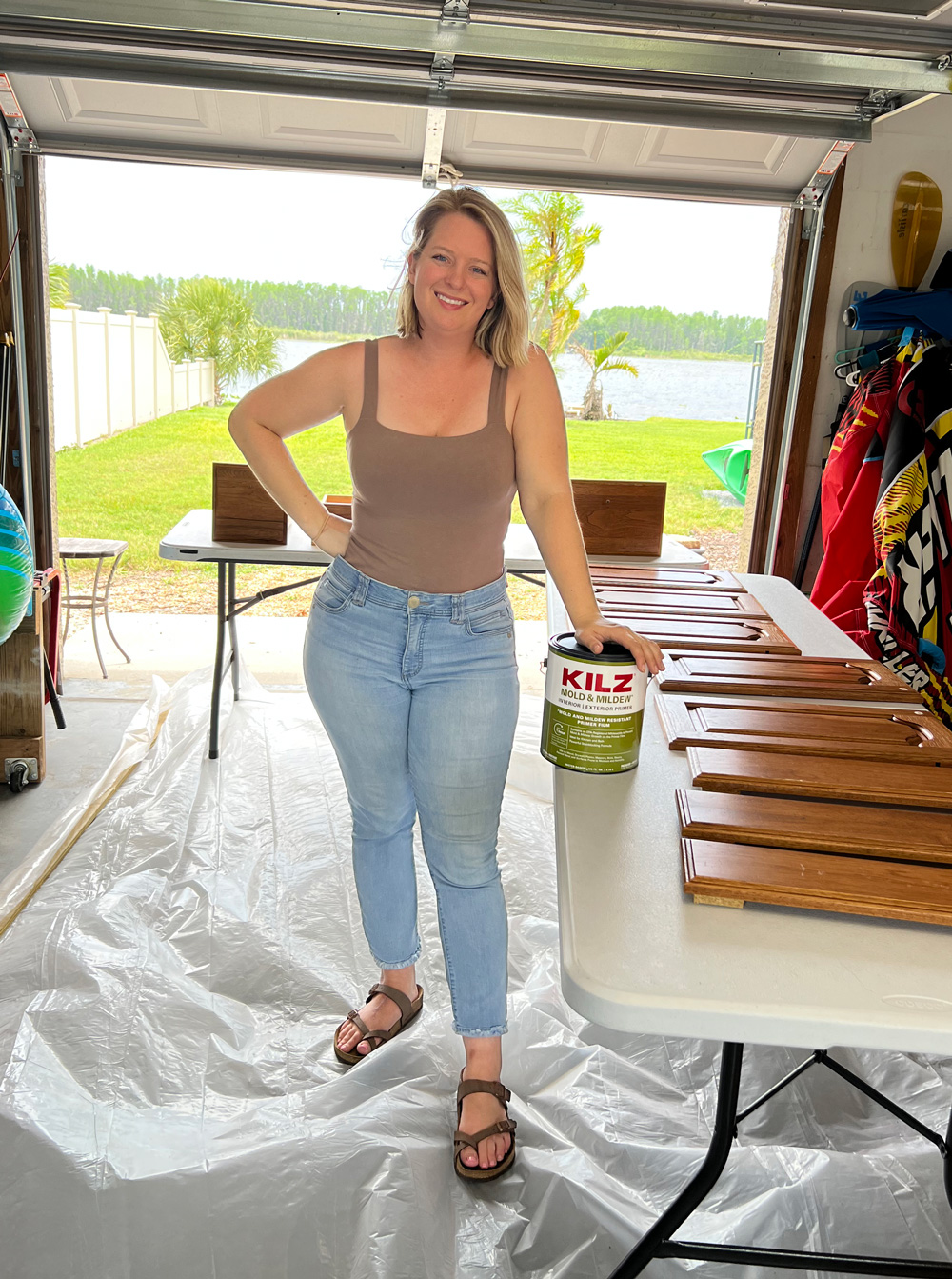 As a licensed general contractor and real estate investor, I know that priming is a fundamental step in completing any paint project. Without primer, paint may peel, crack or flake, resulting in a poor and unsatisfactory finish. And when it comes to achieving a flawless and Instagram-worthy finish, primer is absolutely essential. KILZ® Primers are a good choice as they offer consistent, dependable results.
As a licensed general contractor and real estate investor, I know that priming is a fundamental step in completing any paint project. Without primer, paint may peel, crack or flake, resulting in a poor and unsatisfactory finish. And when it comes to achieving a flawless and Instagram-worthy finish, primer is absolutely essential. KILZ® Primers are a good choice as they offer consistent, dependable results.
Recently, I decided to do a quick weekend project to update my mom’s ensuite bathroom cabinets. The bathroom has beautiful solid wood cabinets but are a little outdated with a medium-to-dark wood finish. The bathroom has also not been renovated in over 20 years and needed a modern refresh. Painting the cabinets was the perfect solution to updating the space quickly while also making the room brighter.
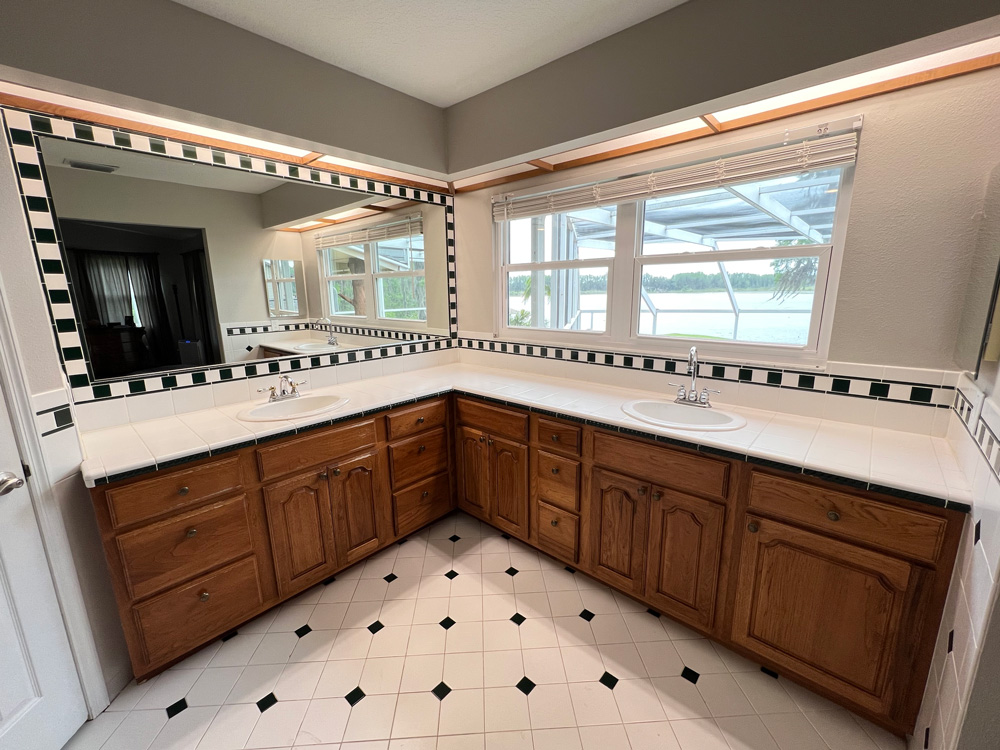
Her primary suite is located on the second floor of the home overlooking a beautiful lake just outside Tampa, Florida. She has been in this home for over 35 years and raised our family here, so it was nice to be able to give back to our family home. To minimize the mess, I removed the cabinet drawers and doors and took them downstairs to the garage where I set up a workstation.
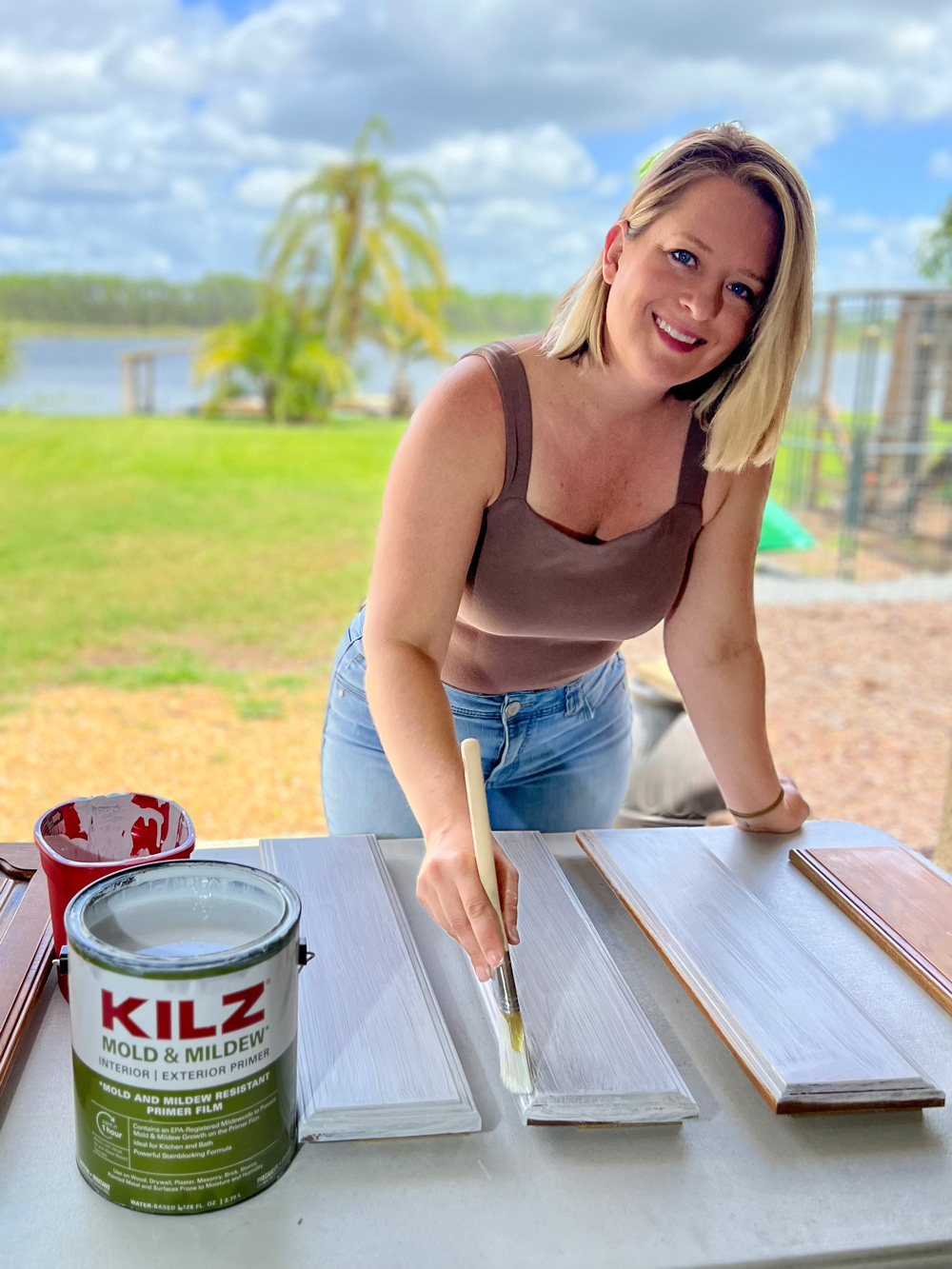 In the garage, I used a few drop cloths to make sure everything stayed clean and pristine. I set up two tables to create an “assembly line of painting,” where I would sand, prime, and paint. The cabinets were solid wood but had a lacquer finish that I wanted to make sure we could cover. To start the process and ensure a beautiful end result, I scuff sanded down all of the doors and drawers with 150-grit sandpaper and then did a final pass with 220-grit paper. Don’t forget to wear safety gear during this step, I made sure to wear a mask and eye protection.
In the garage, I used a few drop cloths to make sure everything stayed clean and pristine. I set up two tables to create an “assembly line of painting,” where I would sand, prime, and paint. The cabinets were solid wood but had a lacquer finish that I wanted to make sure we could cover. To start the process and ensure a beautiful end result, I scuff sanded down all of the doors and drawers with 150-grit sandpaper and then did a final pass with 220-grit paper. Don’t forget to wear safety gear during this step, I made sure to wear a mask and eye protection.
After sanding, I was ready to prime! The primer that we used for this project was KILZ® MOLD & MILDEW Primer. This primer is a water-based, primer-sealer-stain blocker that is specially designed for residential surfaces in high humidity, moisture, and temperature environments such as kitchens, bathrooms, powder rooms, and laundry rooms.
KILZ® MOLD & MILDEW Primer offers excellent adhesion to the surfaces of the bathroom cabinets, ensuring that the paint would stick and stay in place even with high moisture levels typical of bathrooms. Additionally, the EPA-registered active ingredient in this primer creates a mold and mildew-resistant film that protects the primer film from developing mold and mildew growth.
This was particularly important for this personal renovation project for my mom, as it would ensure that her bathroom cabinets would stay mold-resistant in the damp environment. The primer also helped us to achieve a smooth and flawless paint finish.
I applied one coat of KILZ® MOLD & MILDEW Primer, allowing it to dry for 2 hours before moving on to the topcoat. We chose Magnolia Home by Joanna Gaines® Cabinet and Trim Paint which I was excited to use for the first time. My mom looked at the color options online and choose the color “Emmie’s Room” which is a very light shade of green.
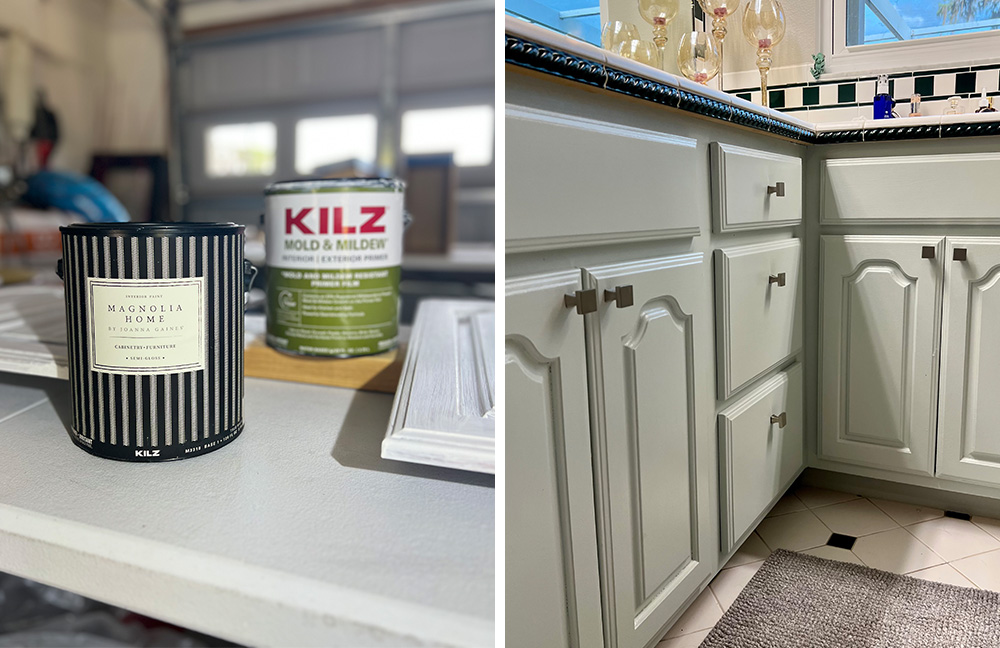
This very light green color complemented the existing white and green tiles in the bathroom perfectly, creating a cohesive and modern look. We applied two coats of the topcoat, allowing each coat to dry completely before applying the next. The final result was stunning and transformed the old and dated bathroom cabinets into a fresh modern look and personally, I think it made the room look much larger.
Not only did this bathroom cabinet refresh make the room look brighter and more modernized, but it also saved my mom a significant amount of money compared to a complete bathroom renovation. When I finally let her come in to see the final results, she couldn’t believe it was the same cabinets. She told me they looked brand new and straight out of a home renovation TV show.
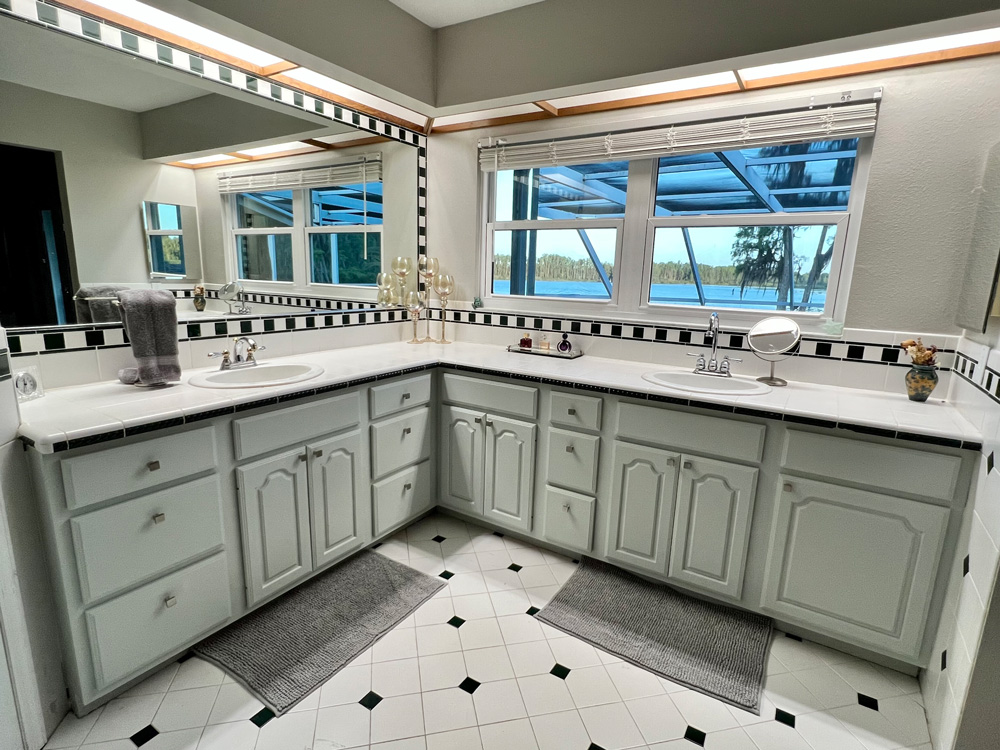
In conclusion, priming is a crucial step in any paint project, no matter how big or small. Not only does it set the foundation for a long-lasting and beautiful finish, but it also ensures that the paint adheres properly to the surface. KILZ® MOLD & MILDEW Primer is an excellent choice for bathrooms and kitchens.
Overall, this project was a personal one for me, as it was a renovation for my mom, who has been my biggest supporter throughout my career. Recently, we started renovating a few investment houses together so it was an honor for her to ask me to work in our family home as well. With KILZ® MOLD & MILDEW Primer and the right workspace, we were able to achieve a beautiful and modernized look for her bathroom cabinets.
To learn more about primer solutions, visit kilz.com.
Always remember to refer to our website kilz.com or product back labels for additional information on which primer is right for your project and detailed instructions on how to apply our products. Check out our Coverage Calculator to understand your estimated paint needs for your upcoming project.
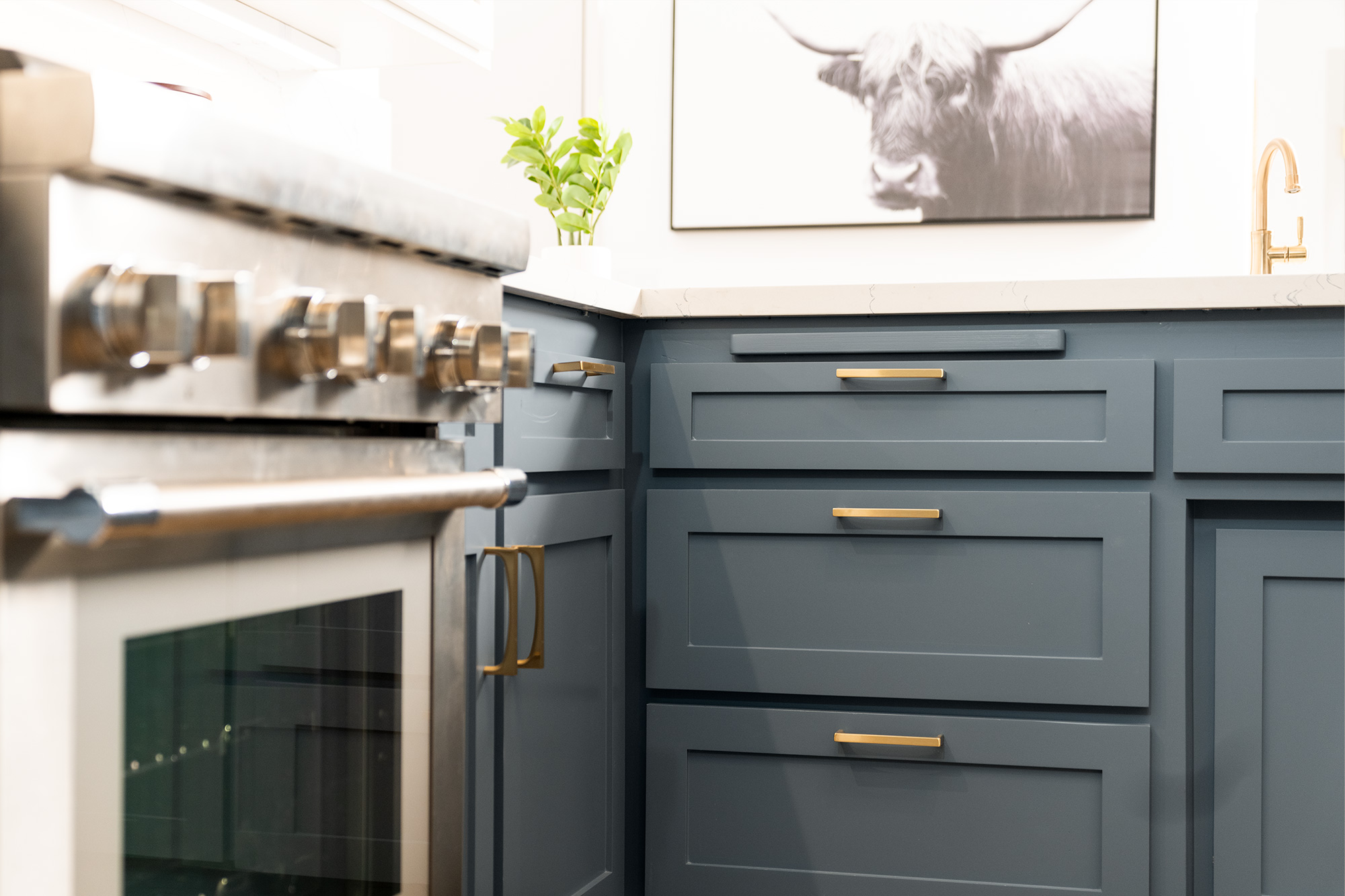
Updating a Kitchen for a New Generation
April 17, 2023We’re excited to share details from our Destination Restoration series with an inspired kitchen refresh that doesn’t require gutting the entire kitchen. This series demonstrates how you can breathe new life into an older home (in this case, a 4th generation family home), while keeping its structural integrity intact.
Our expert design and restoration team — Jason Lai (interior designer) and Jared Foster (contractor/pro painter) — worked together to transform a kitchen that was well past its prime. They first conceptualized which cosmetic changes would make the most impact, and then rather than gutting the entire room and starting from scratch, they repurposed and restored. By refreshing dull wooden cabinets, creating bar seating with a stunning new look, replacing heavy black appliances, and updating hardware, countertops, and backsplash, they transformed a dark and dated kitchen into a bright, airy, and modern one, renewing it for years to come.
If it’s your first time restoring a kitchen, it can feel like a big undertaking, which is why we broke down what we did below, so you can get a more detailed understanding of how we upgraded the heart of the home. We’ve also included a step-by-step guide on how to paint kitchen cabinets for a refresh.
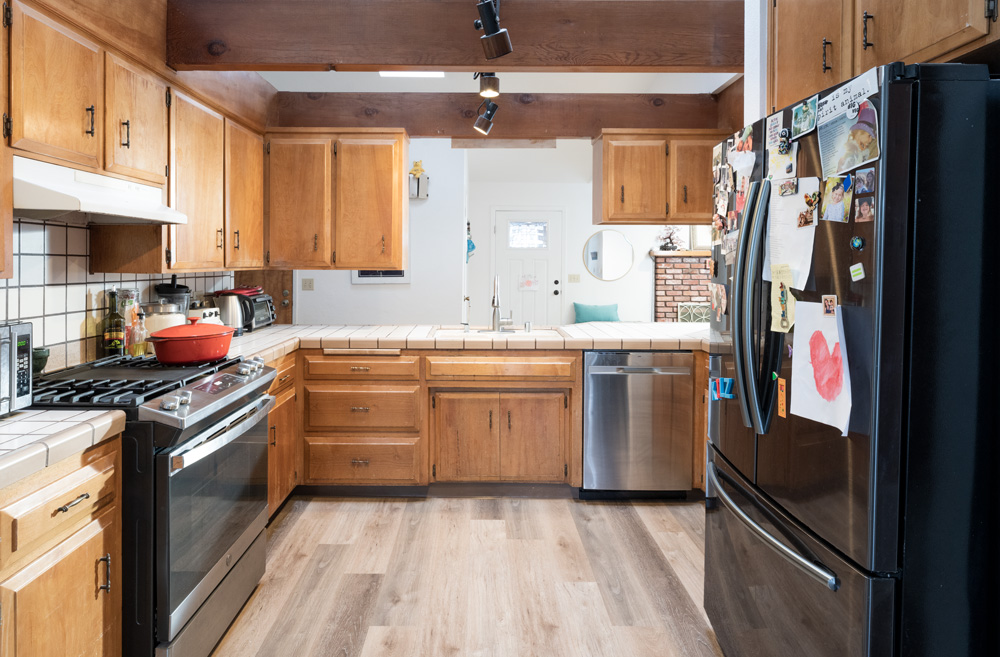
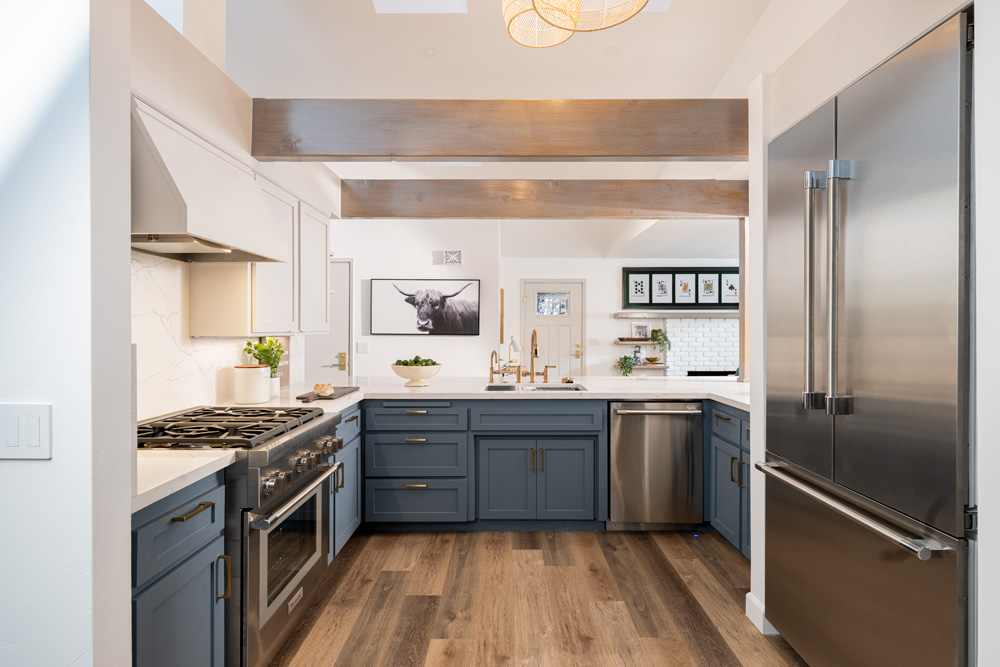
Cabinetry
Rather than ripping out and replacing the cabinetry, which can be costly, we gave them a brand-new look and feel with a few simple updates. We removed some of the upper cabinets and modernized the rest by making them shaker style. Then we used KILZ 3® Premium Primer to prep them for a fresh coat of paint. To create some contrast and brightness in the room, we chose Charcoal Blue for the lower cabinets and Chic Grey for the upper, both colors by Behr Paint. Finally, we fitted them with all new hardware.
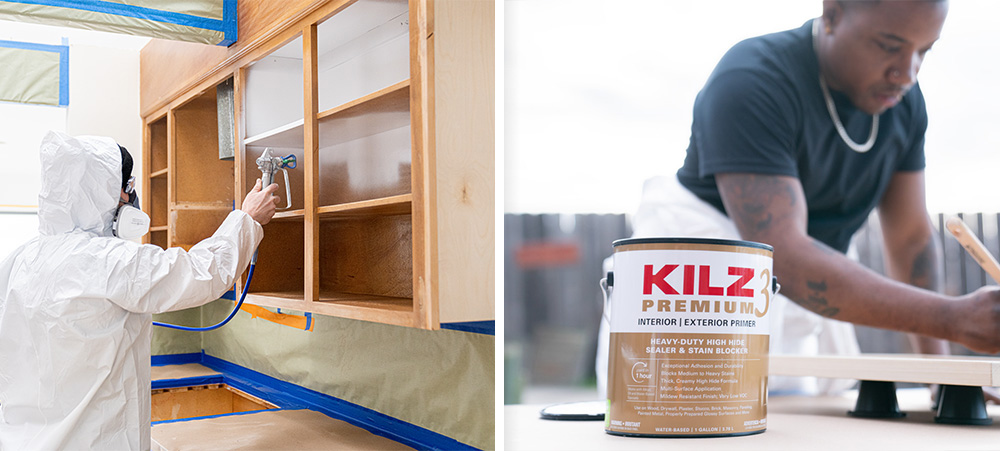
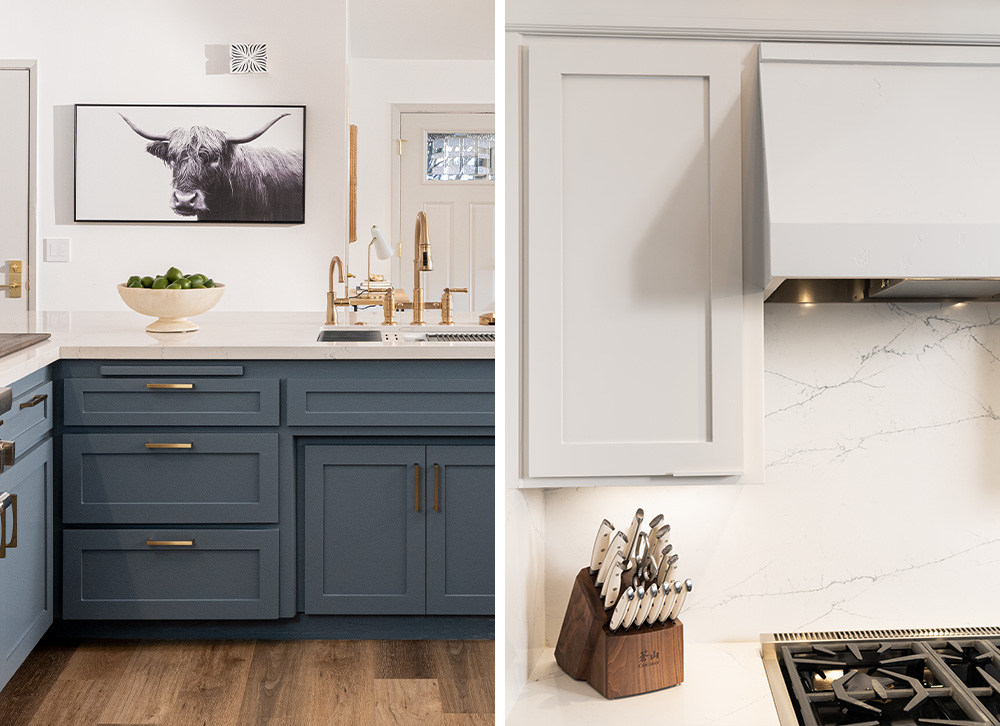
Ceiling
Because it wasn’t structural, we removed the center beam and stained the remaining beams to match the floors. (Check out the Living/Dining Room restoration to see where that center beam ended up!) We also installed recessed lighting by Kichler Lighting and rattan pendant lights.
Appliances & Additional Lighting
We updated the hood vent, oven, dishwasher, and refrigerator with stainless steel appliances for a sleeker, modern look. To ensure the hood vent matched the upper cabinets, we plastered, primed (again using KILZ 3 Premium Primer) and painted it using the same Chic Grey (a color by Behr). Finally, we installed under cabinet lighting by Kichler, added new electrical outlets throughout, and updated all electrical switches.
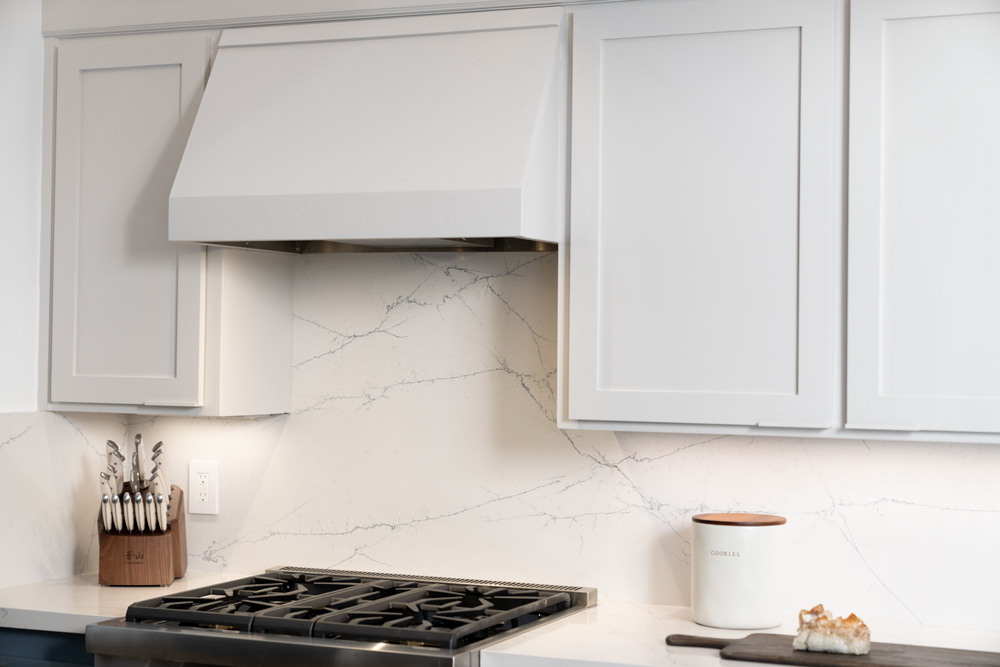
Other Changes
We updated the tile countertops and backsplash with a modern, white marble finish. To extend the bar, we added rounded lower cabinets and primed them (using KILZ 3 Premium Primer) for paint (Charcoal Blue by Behr) to match the others. Lastly, we added a 1×1 rail texture detail under the counter with hidden outlets. The sink, faucet, glass rinser, filtered water faucet, and hardware were all updated new products by Delta Faucet to complement the new look.
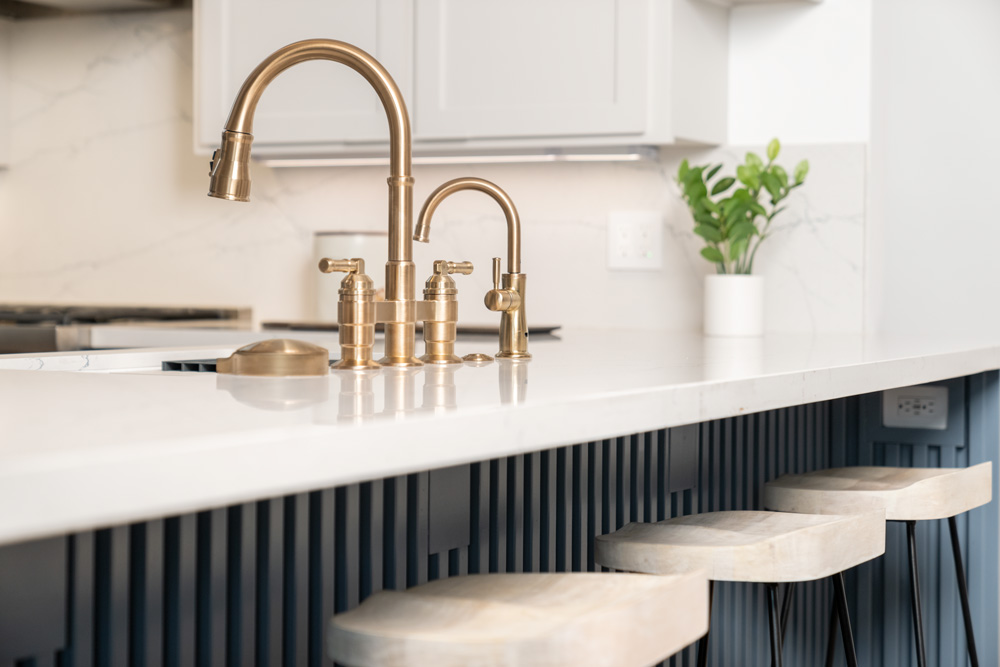
Why Do You Need to Prime?
Priming is essential for proper surface preparation for any paint project. It’s the difference between a job done and a job done right. Priming helps solve a wide range of problems, including highly porous surfaces, stains, odors, uneven surfaces, texture differences, and adhesion problems.
For this kitchen cabinet facelift we used, KILZ 3® Premium Primer, which is ideal for high-touch surfaces and humidity protection. It was perfect for our cabinet refresh thanks to its exceptional adhesion and ability to hide blemishes, stains, and other imperfections, which can accumulate over time, especially in older, generational homes like this one.
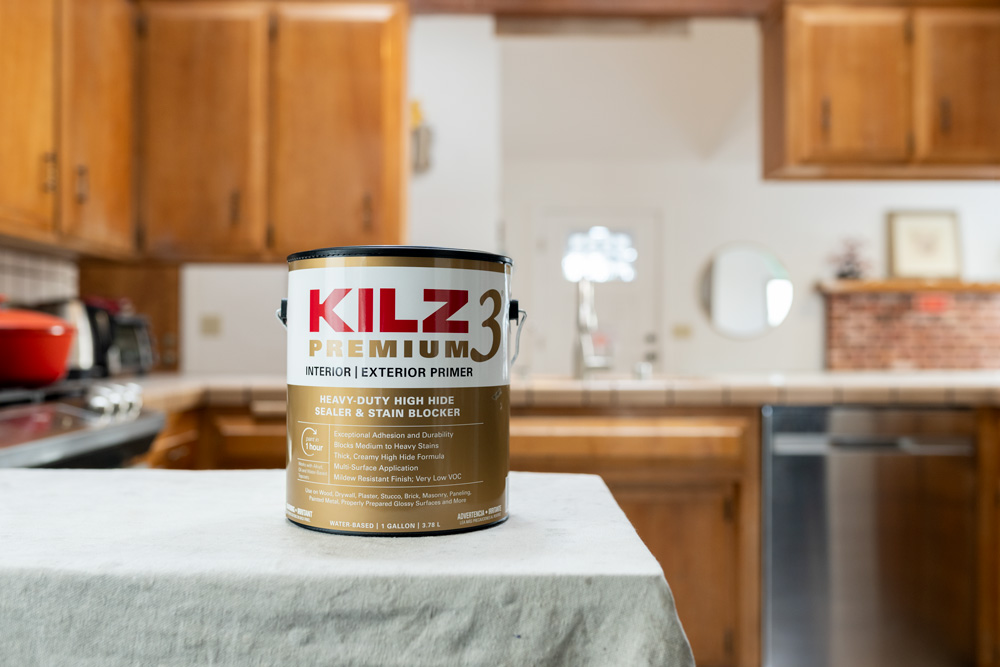
Step-By-Step Guide to Refinish Kitchen Cabinets:
Painting wood kitchen cabinets requires a few basic steps to get the smoothest finish and lasting results. Here’s an easy guide to follow for your next project:
1. Use a screwdriver to remove the cabinet doors and drawers from the cabinet frames and to remove all door handles and hardware.
2. Sand the surfaces of the doors, drawer faces, and cabinet frame to create a smooth surface for priming. Do a first pass with 100-150 grit sandpaper then finish with a second pass of 180-220 grit sandpaper. Remember, the higher the “grit” number, the smoother the finish.
3. When sanding, move the sandpaper in the same direction as the wood grain. If you go against the grain, you will end up with a lot of scratches that will show through your topcoat.
4. After sanding, wipe down the surface with a damp cloth to remove any dust or residue. Allow to dry.
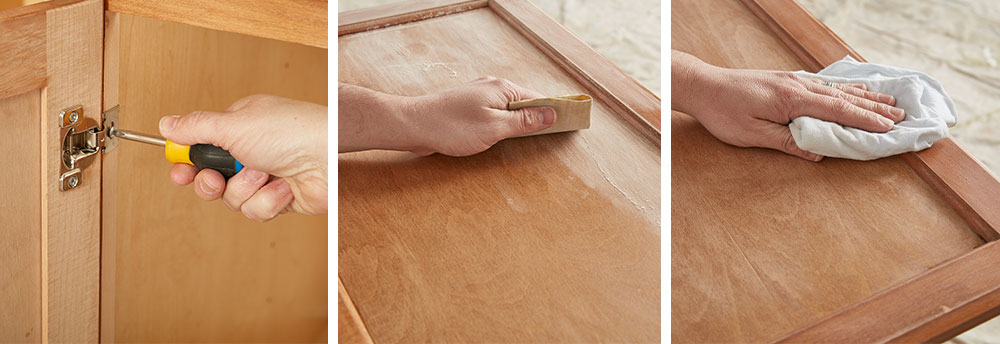
5. Protect your floors and workspace from paint and primer by covering it with a drop cloth.
6. Now it’s time to prime! Using KILZ 3® Premium Primer, use a brush to make smooth strokes that go in the same direction as the wood grain.
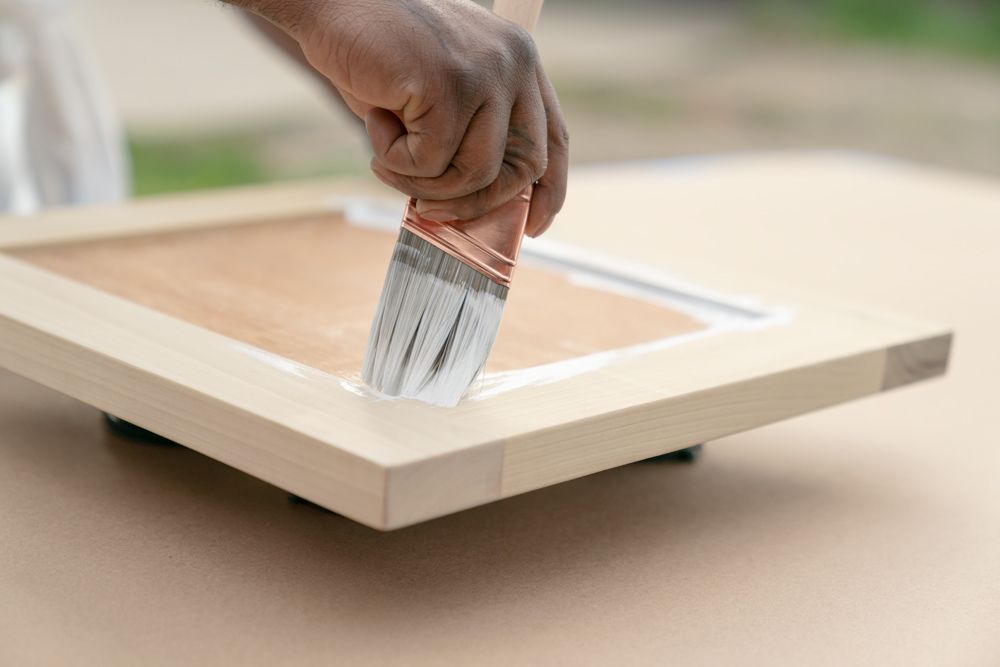
• Pro-tip: To get better coverage along the sides of your door, raise it off your work surface with bricks.
7. Allow to dry for 2 hours.
8. Once the primer is dry, apply your kitchen cabinet paint of choice using the same application process at the primer.
• Pro-tip: For a really great result, apply primer and paint with a sprayer.
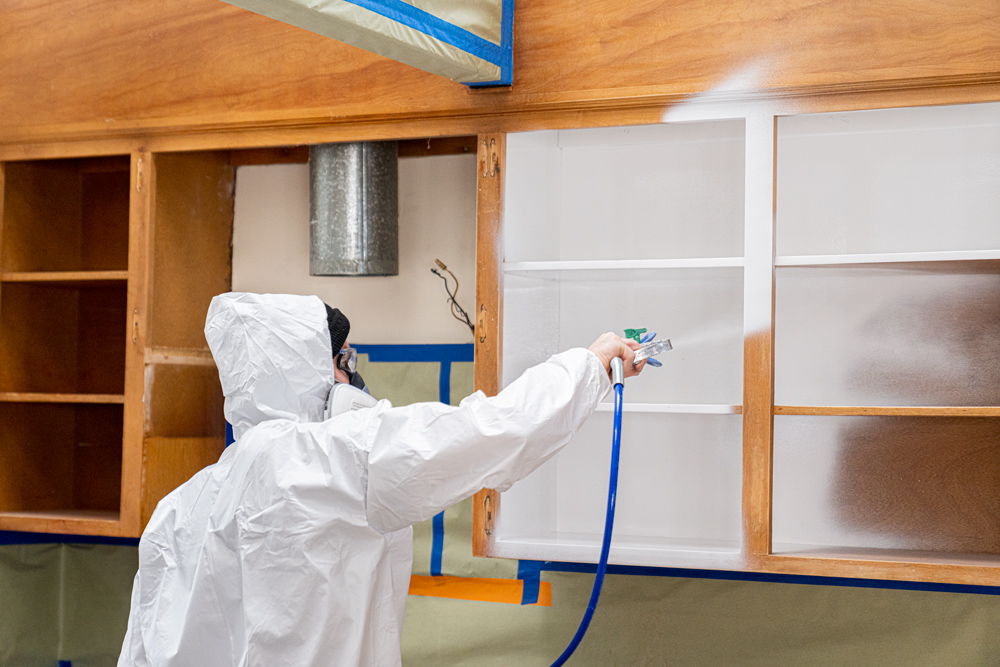
You Will Need:
• Screwdriver
• Dust mask
• 100-150 grit and 180-220 grit sandpaper
• Step ladder for hard-to-reach areas
• Rags to wipe dirty and dusty surfaces
• Painter’s tape
• Drop cloths, canvas, or other reusable material
• Paint roller, brush, and paint tray
• Paint of choice
We hope this episode of Destination Restoration inspires you to take on your own kitchen remodel this year. Be sure to keep KILZ® products in mind for your next project, and come back for more ideas, tips, and project inspiration.
If you loved this restoration, be sure to check out the other episodes of Destination Restoration. Jason and Jared took on the Primary Bedroom, Primary Bathroom, and Living/Dining Room.
Always remember to refer to our website kilz.com or product back labels for additional information on which primer is right for your project and detailed instructions on how to apply our products. Check out our Coverage Calculator to understand your estimated paint needs for your upcoming project.
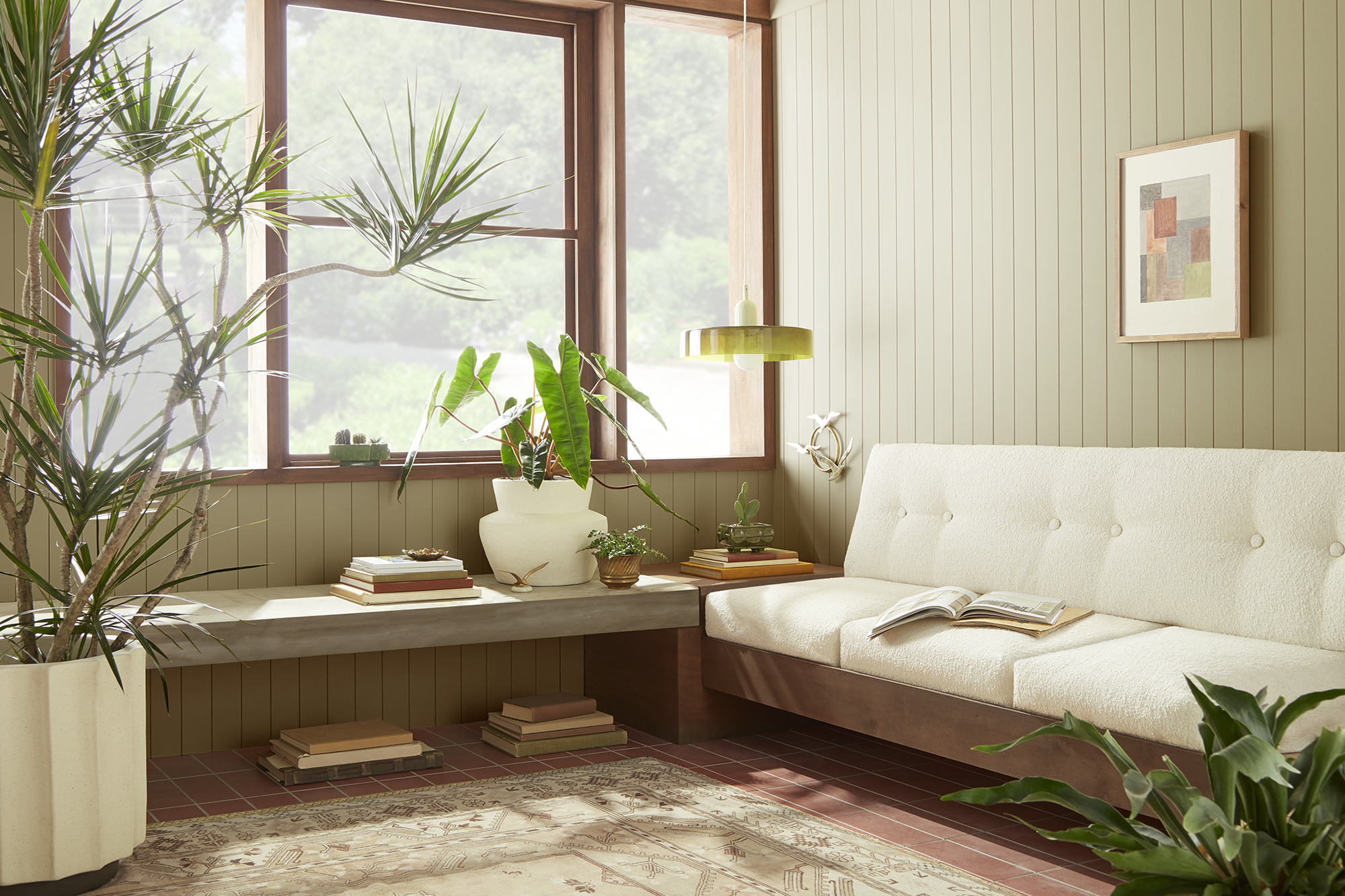

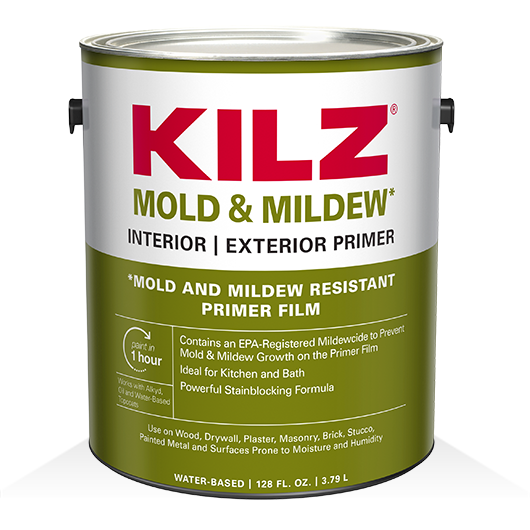
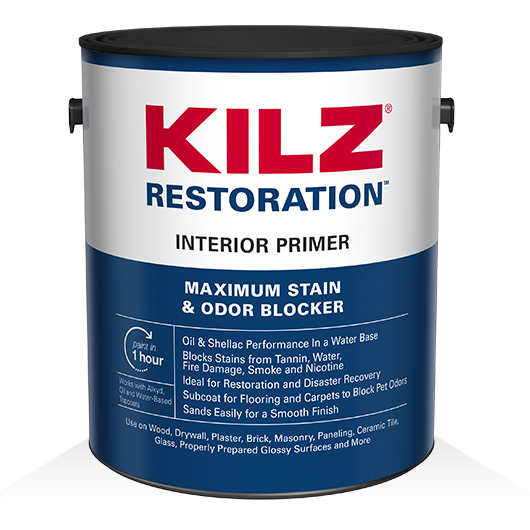
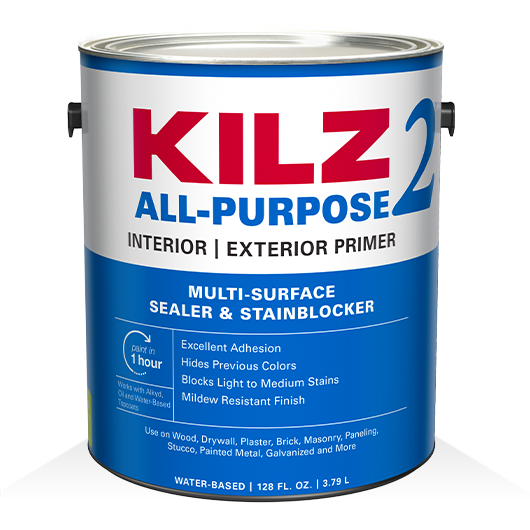
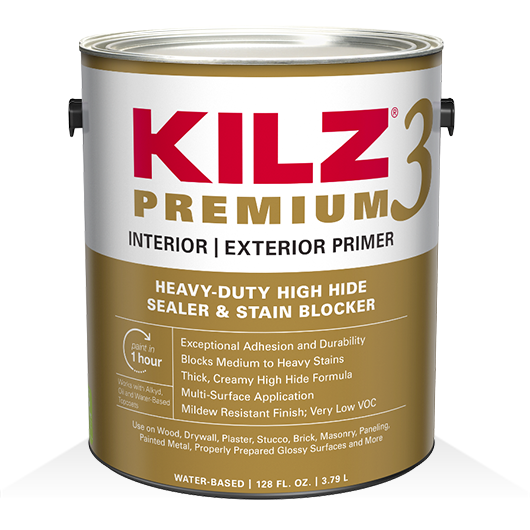
join the conversation:
SHARE this post: